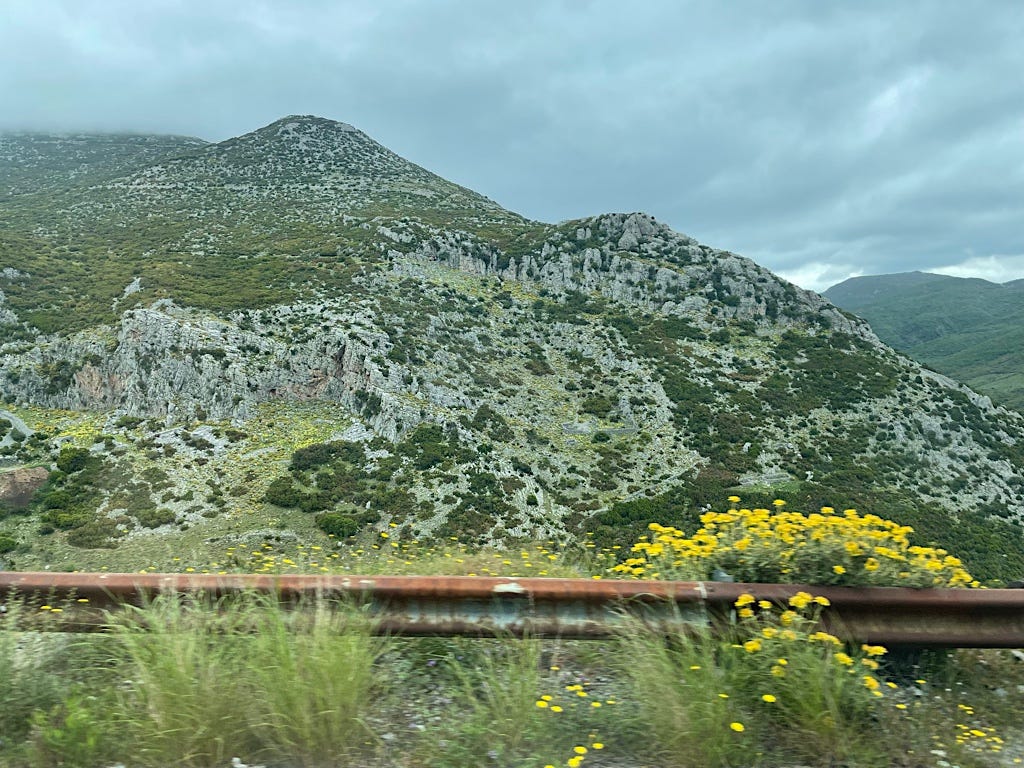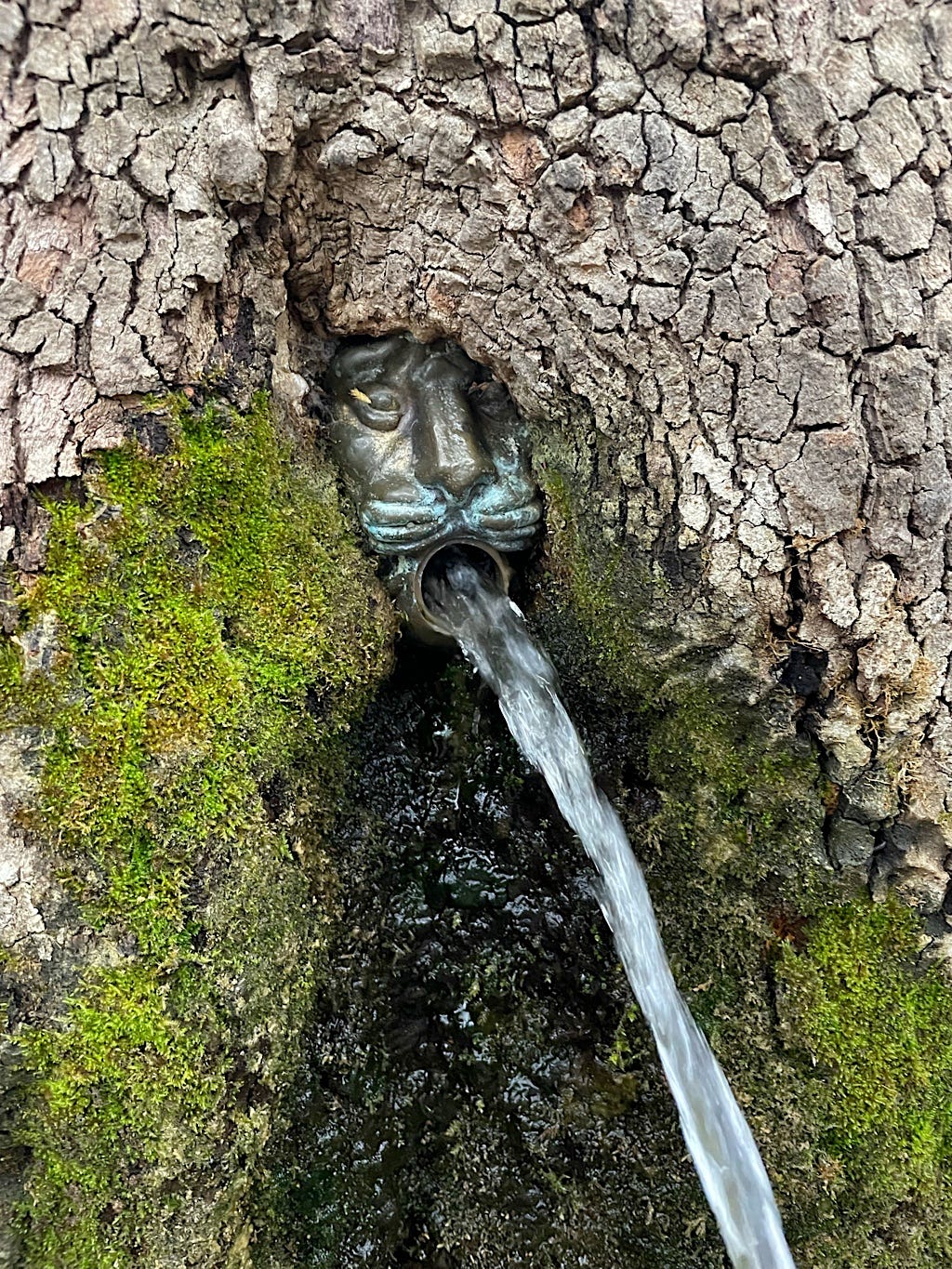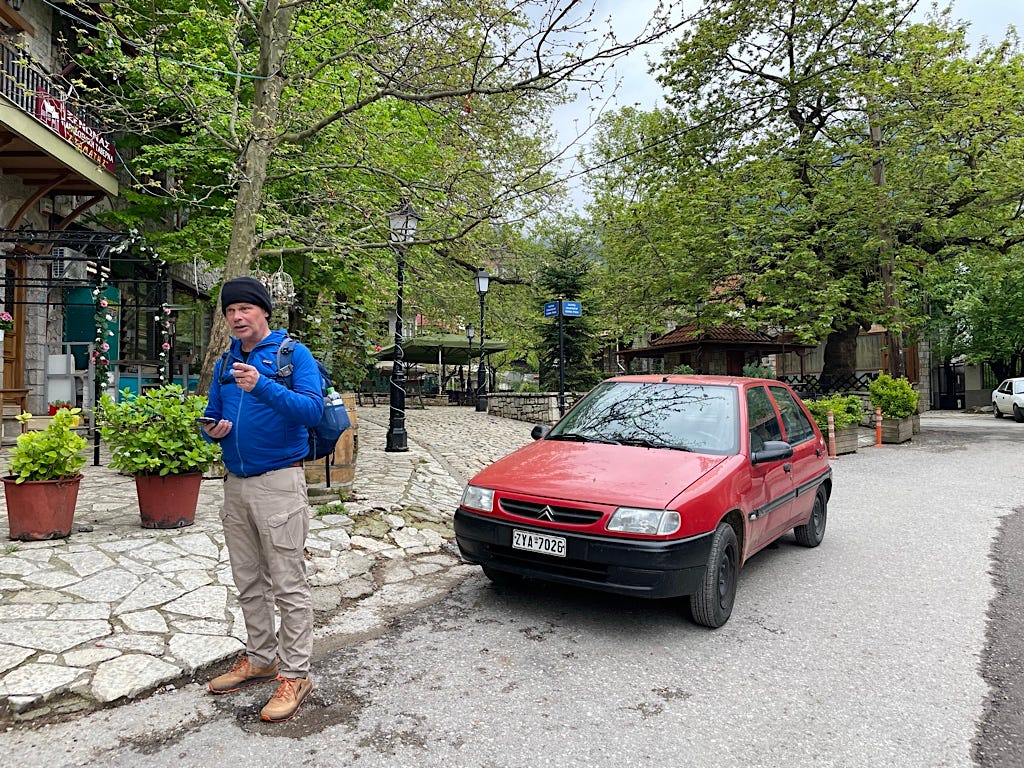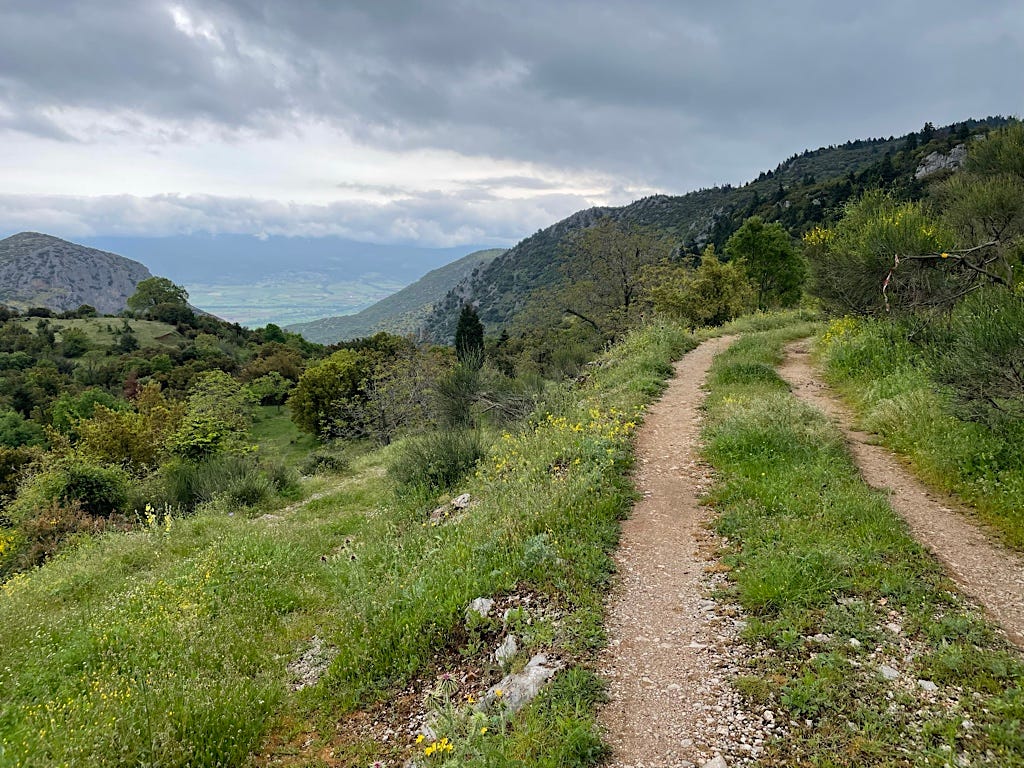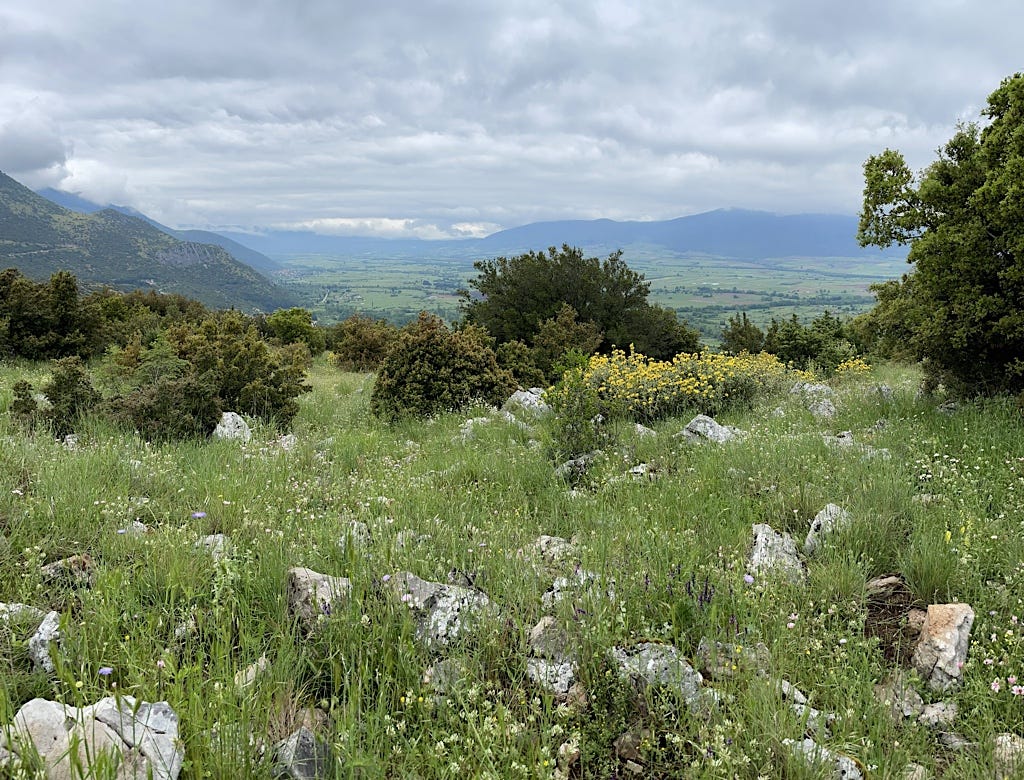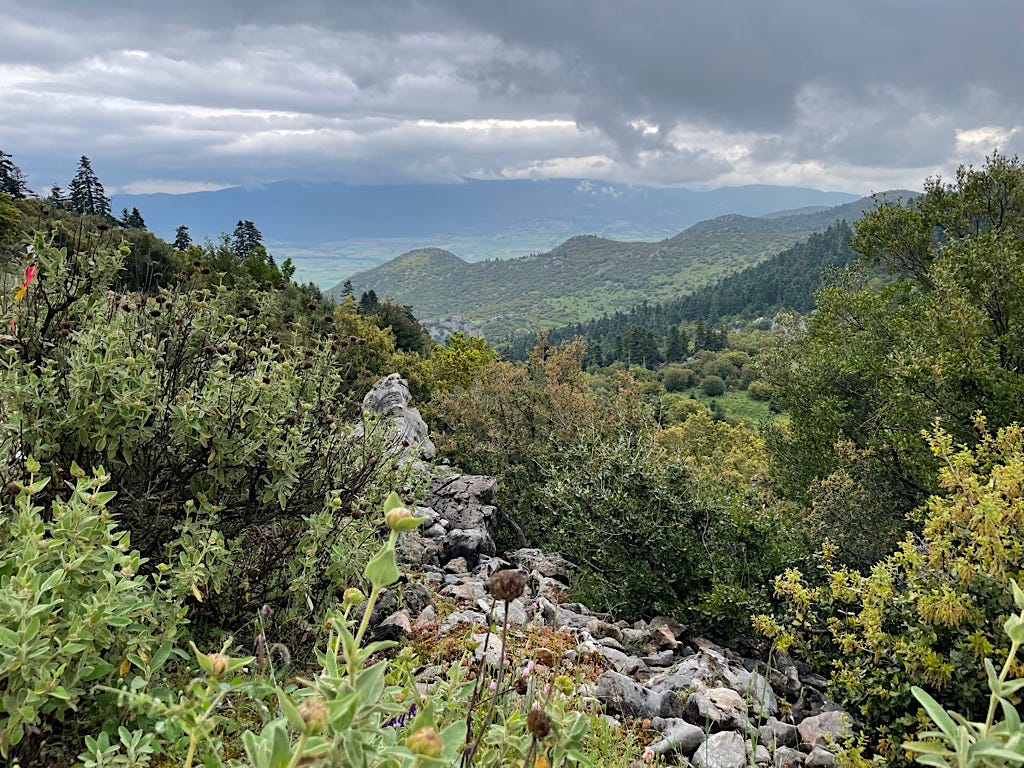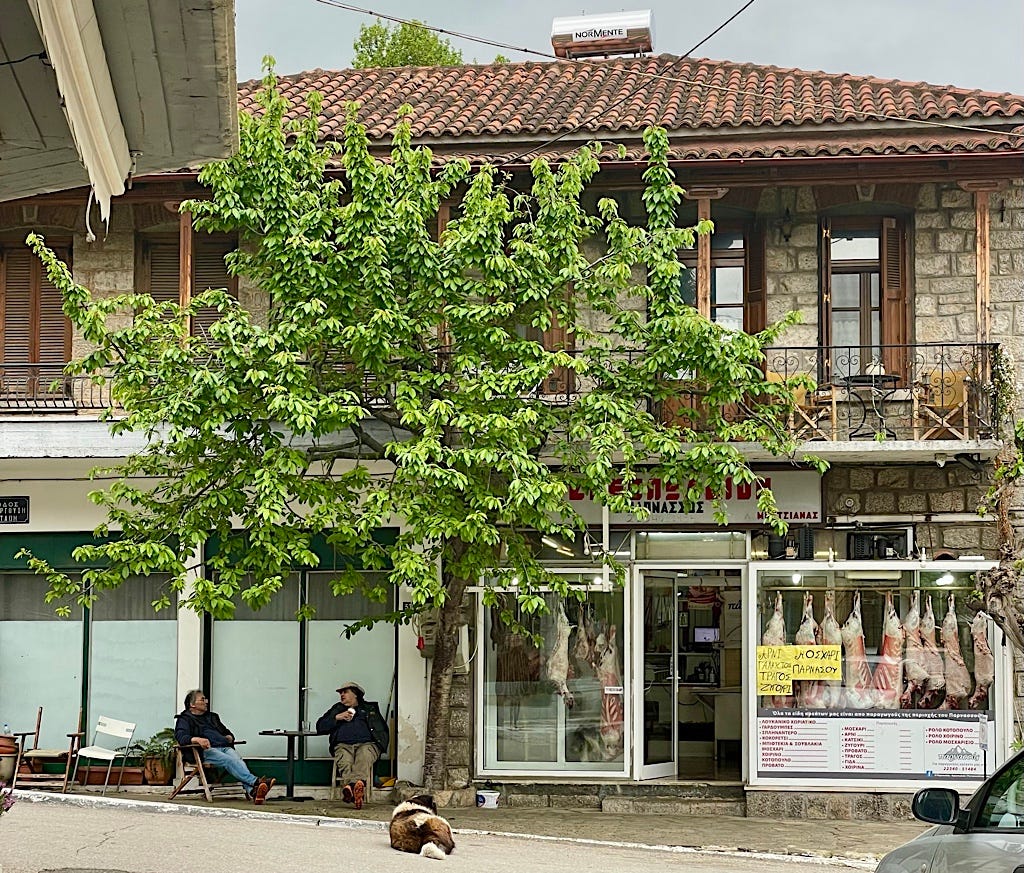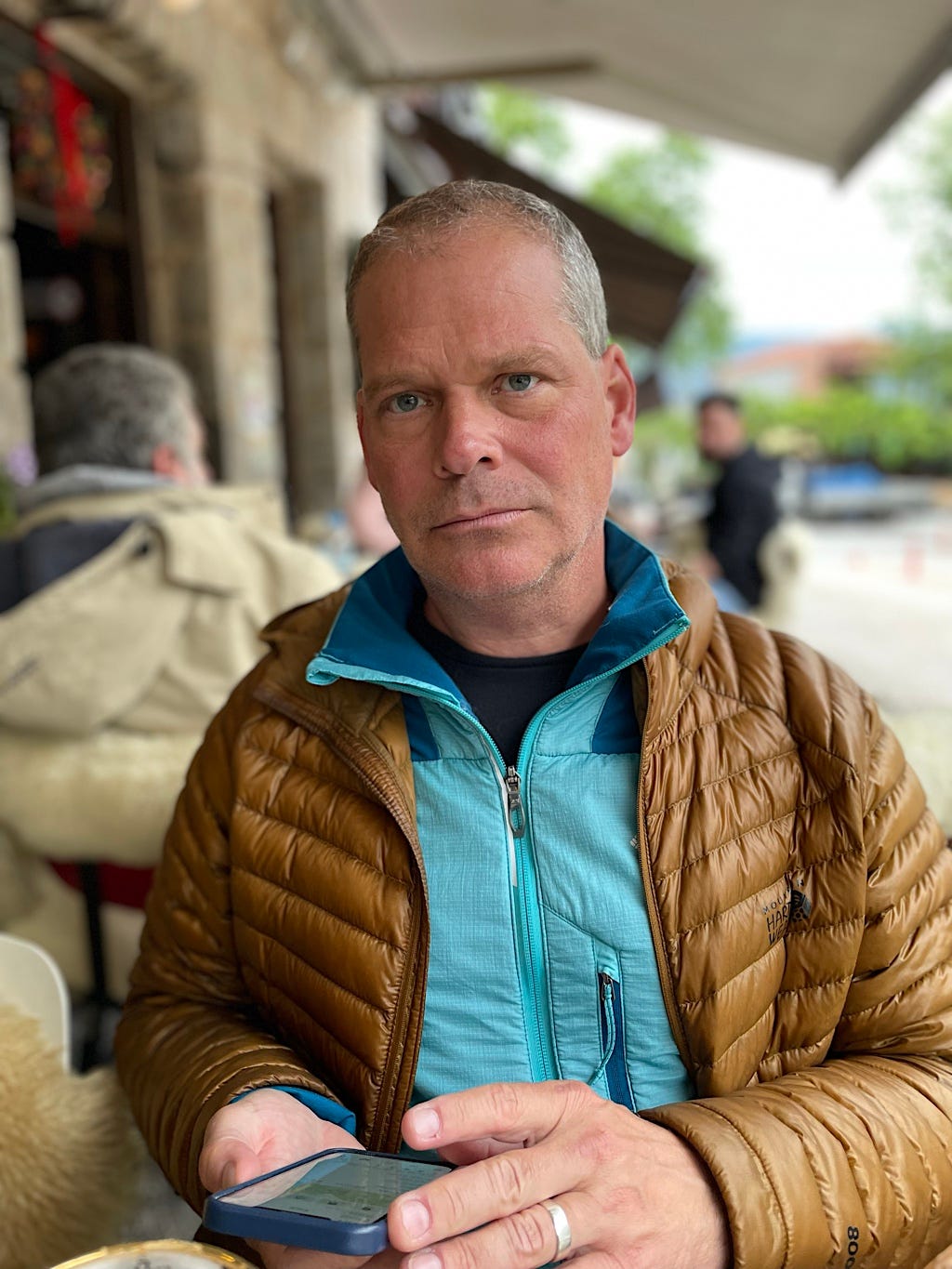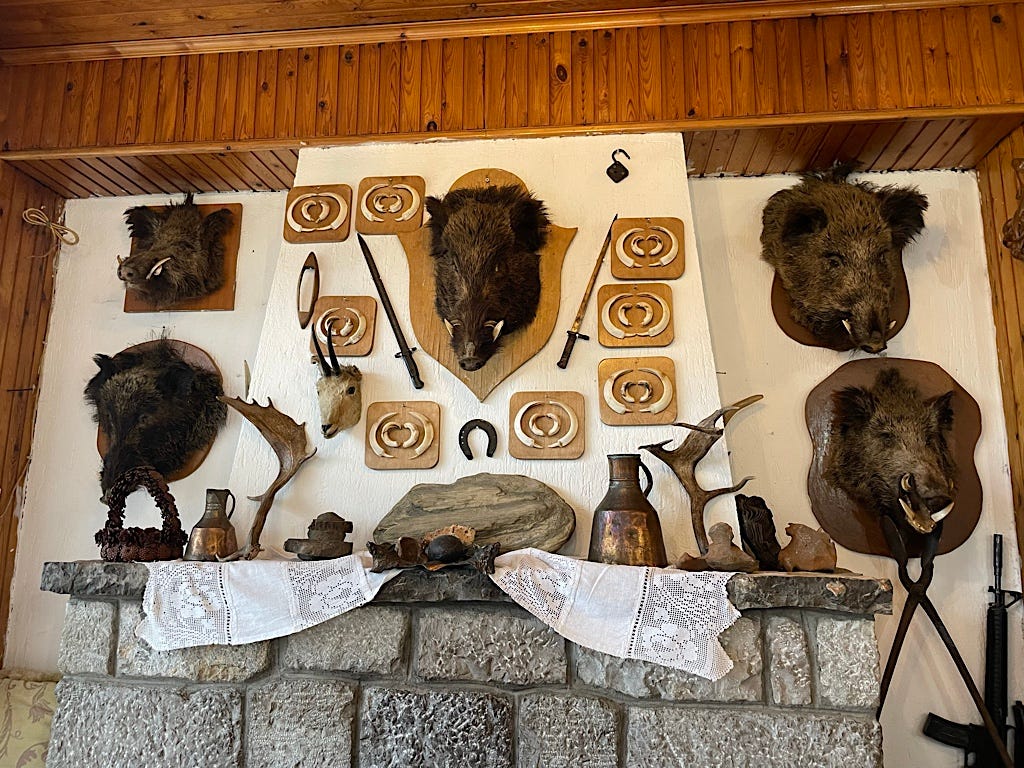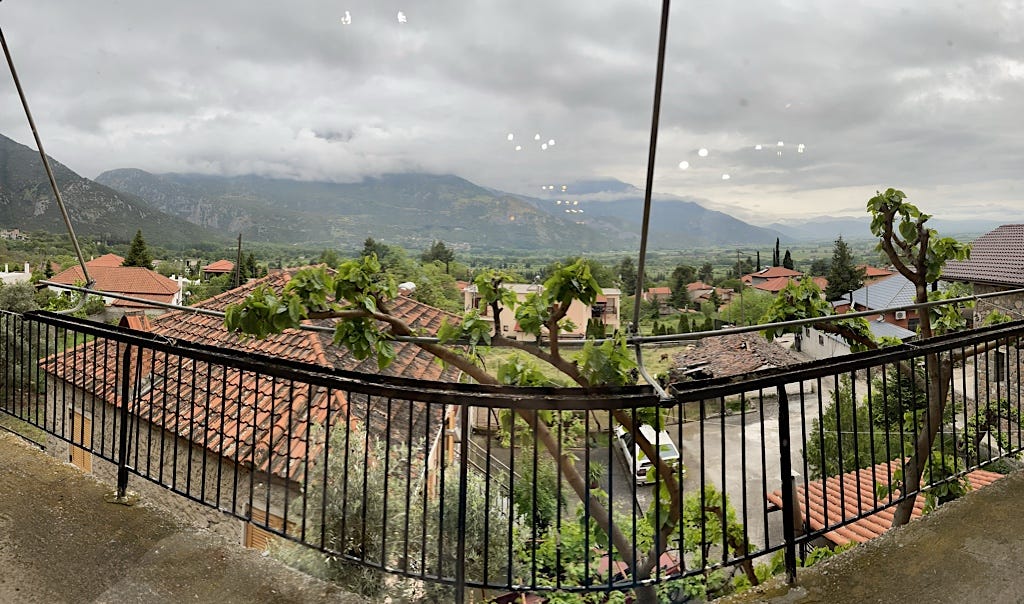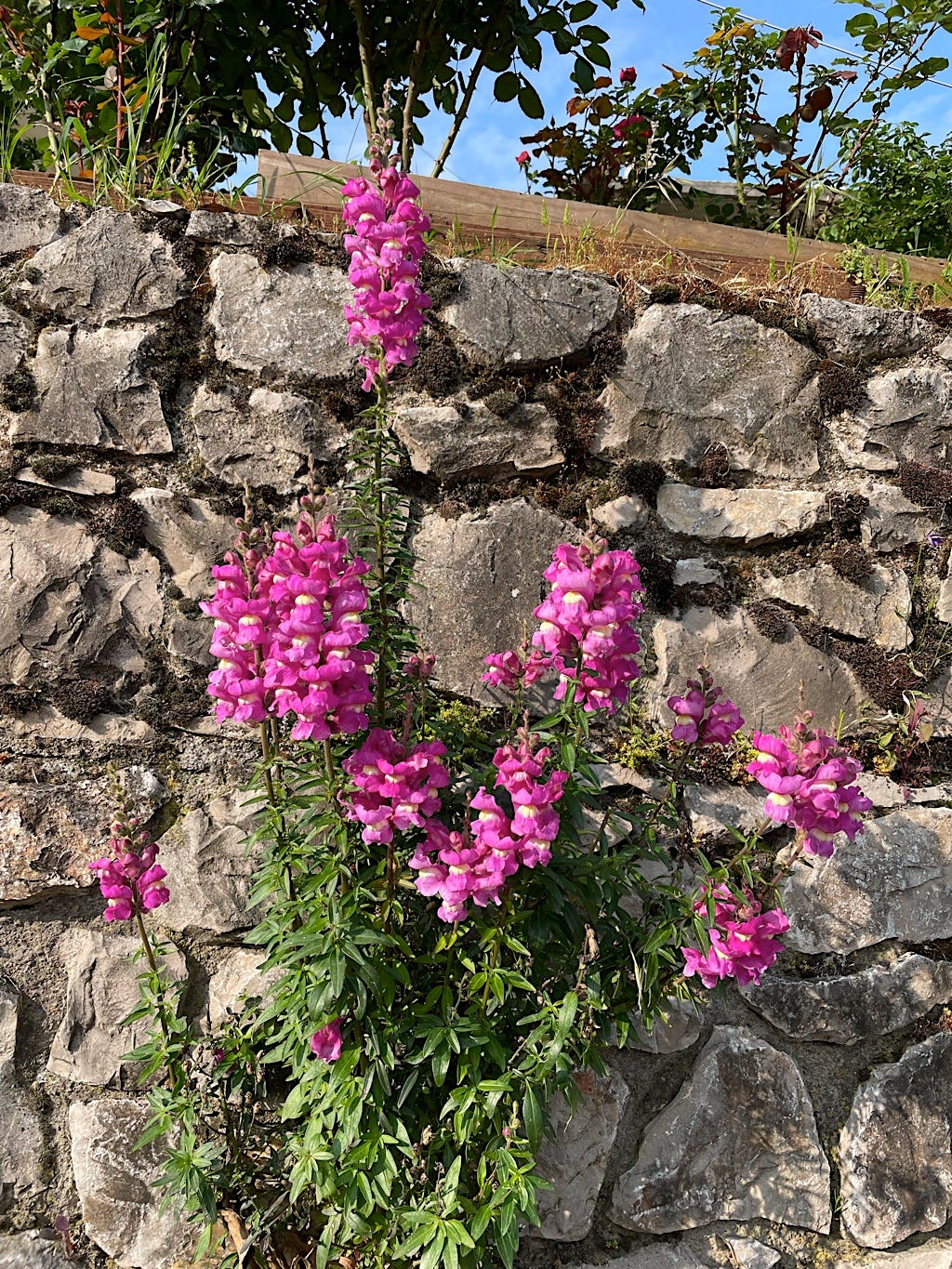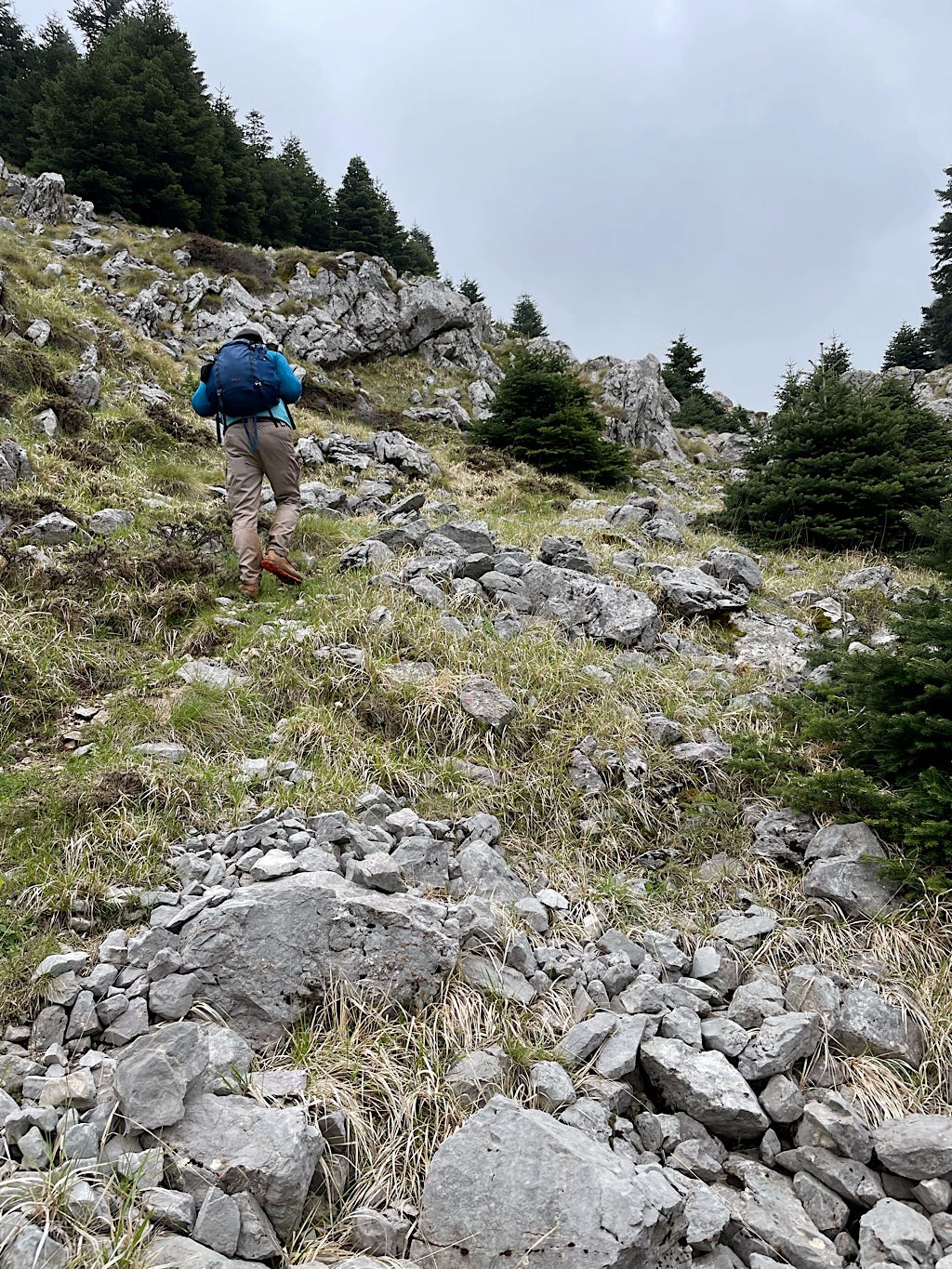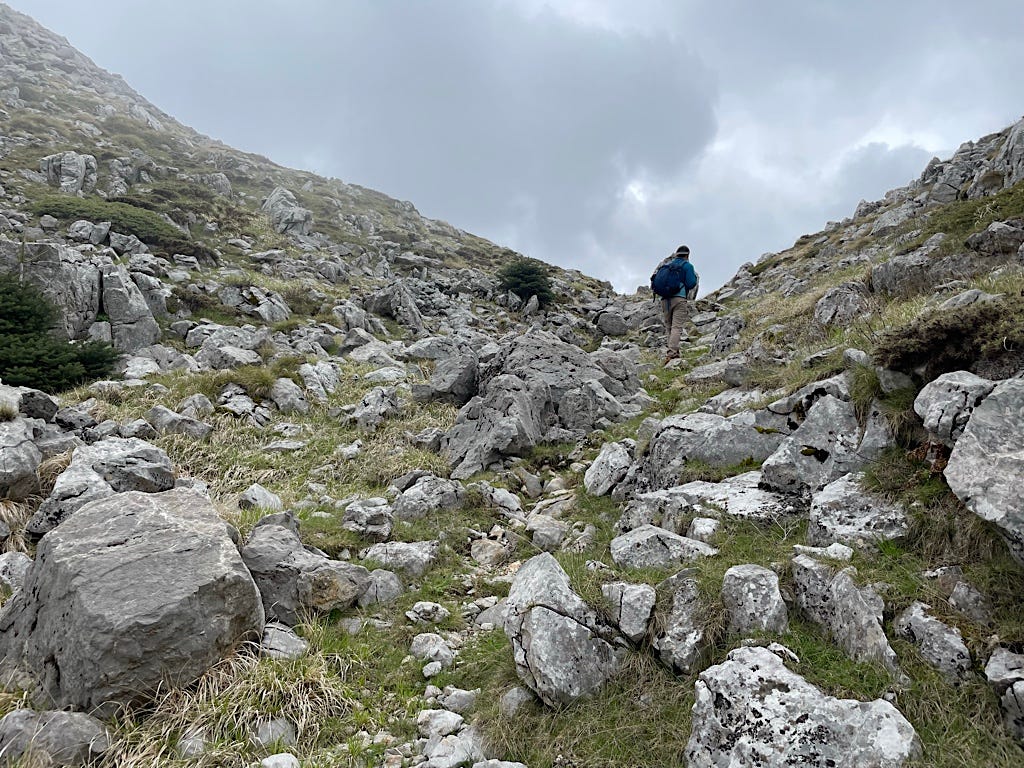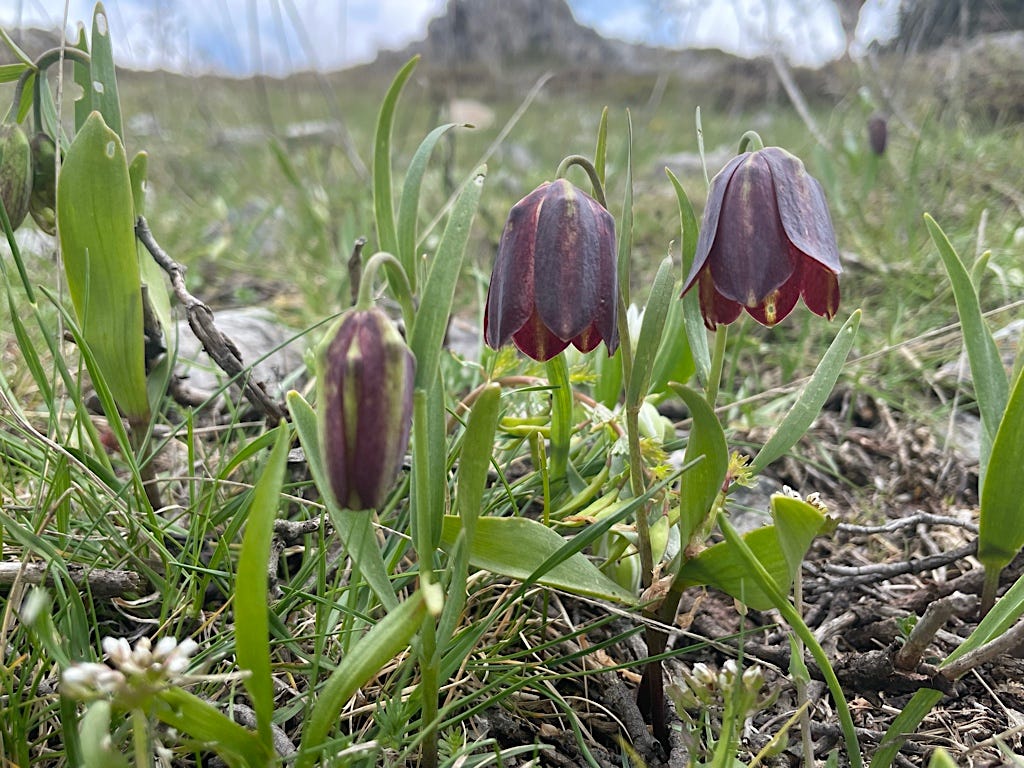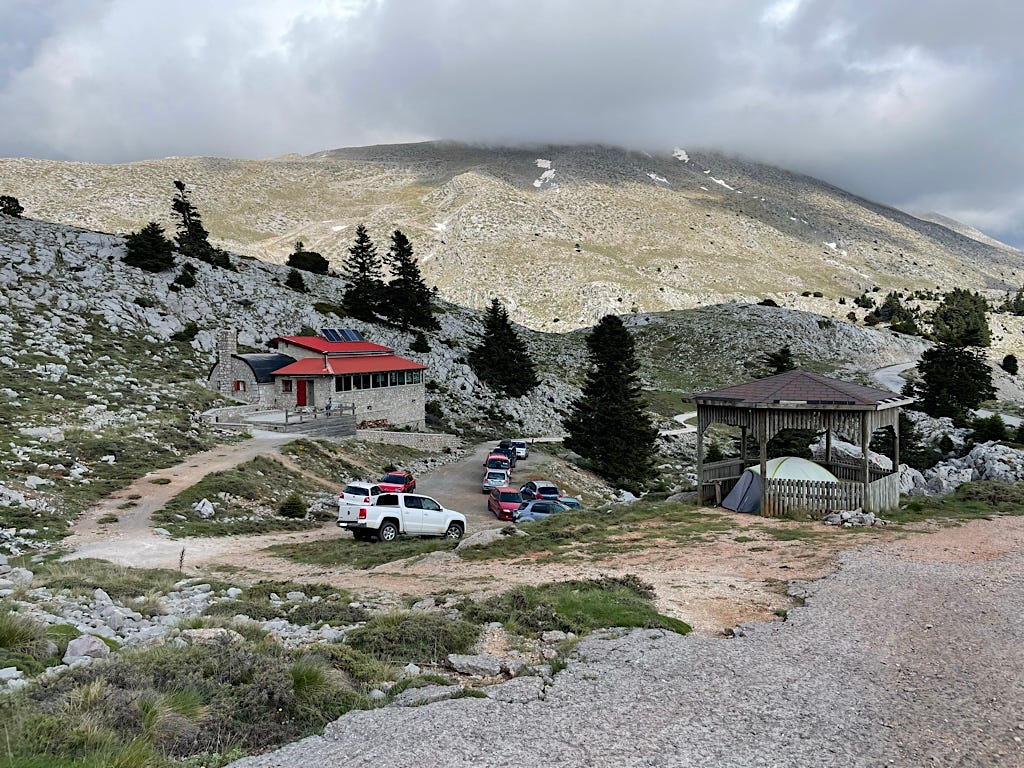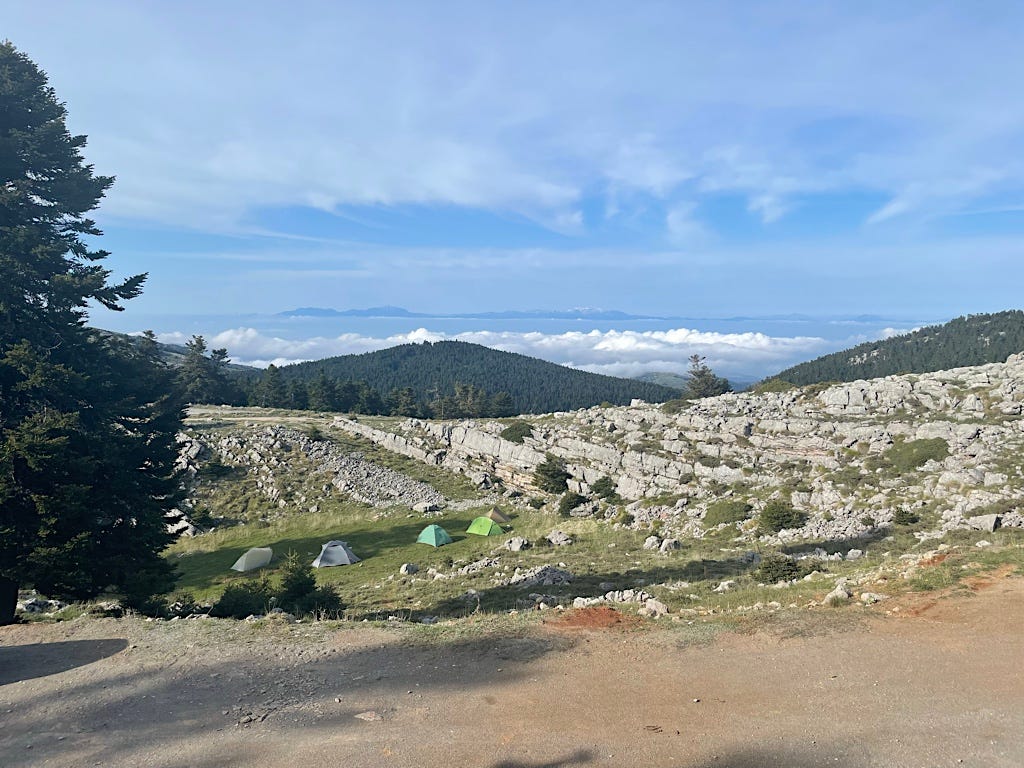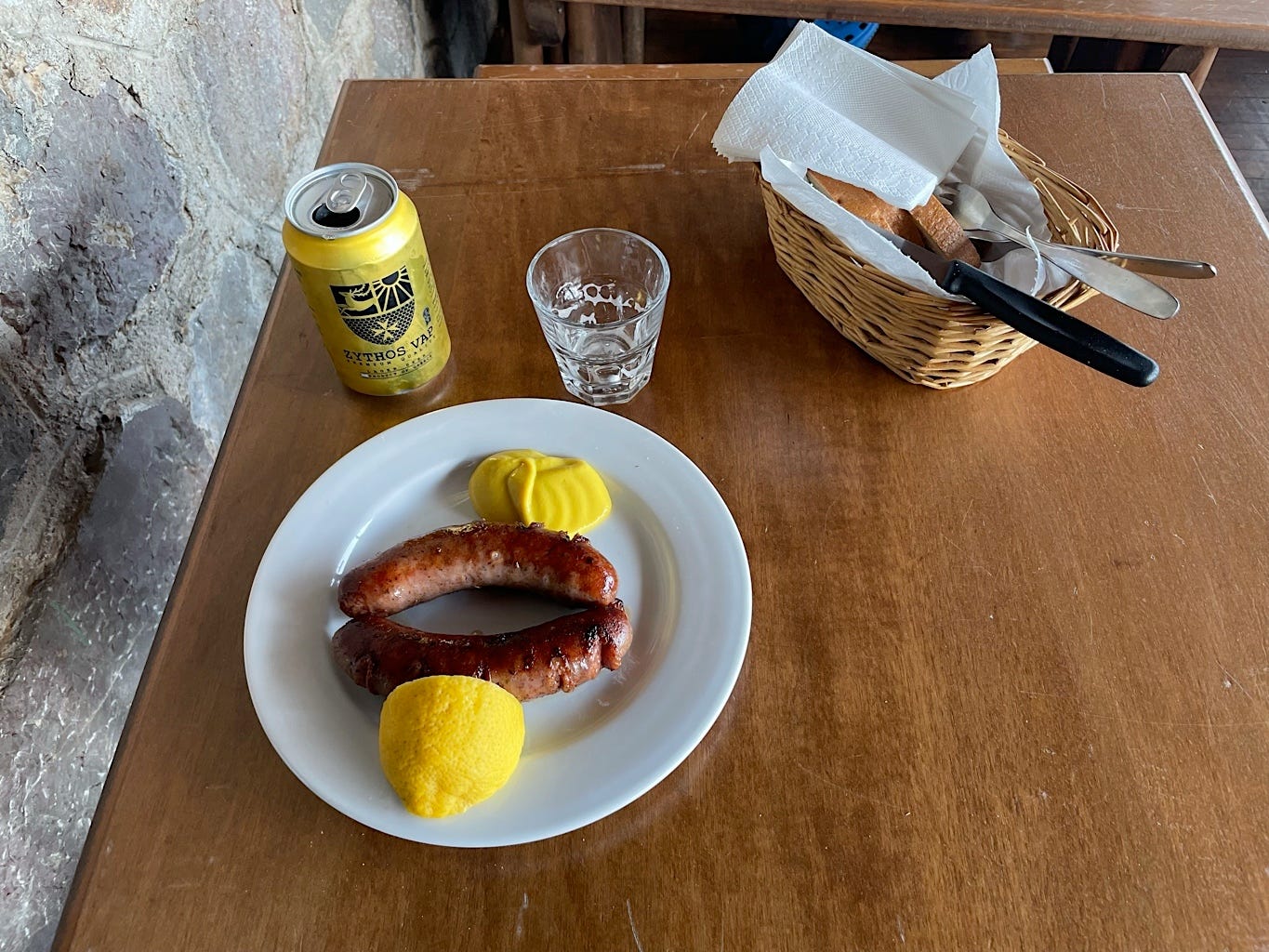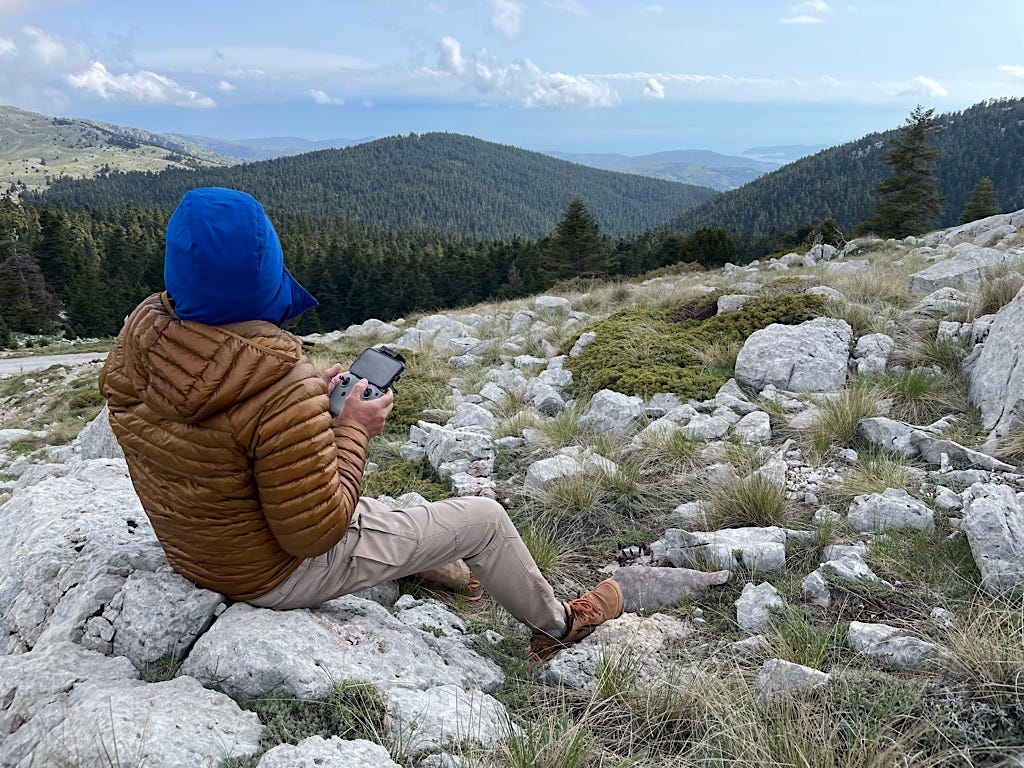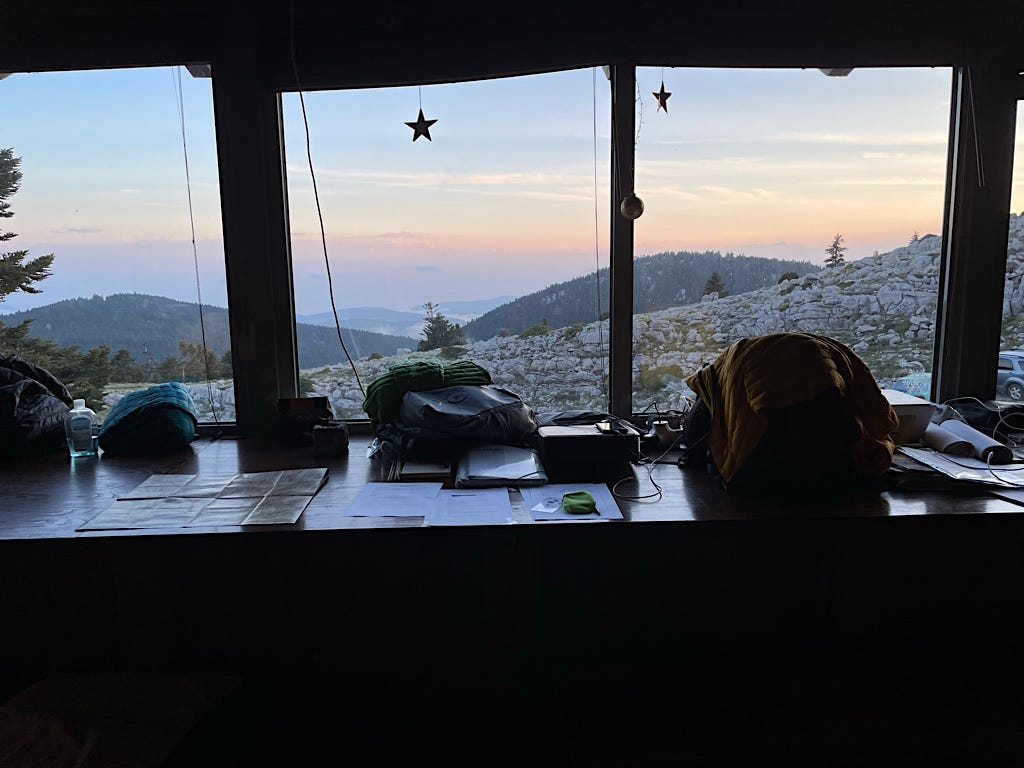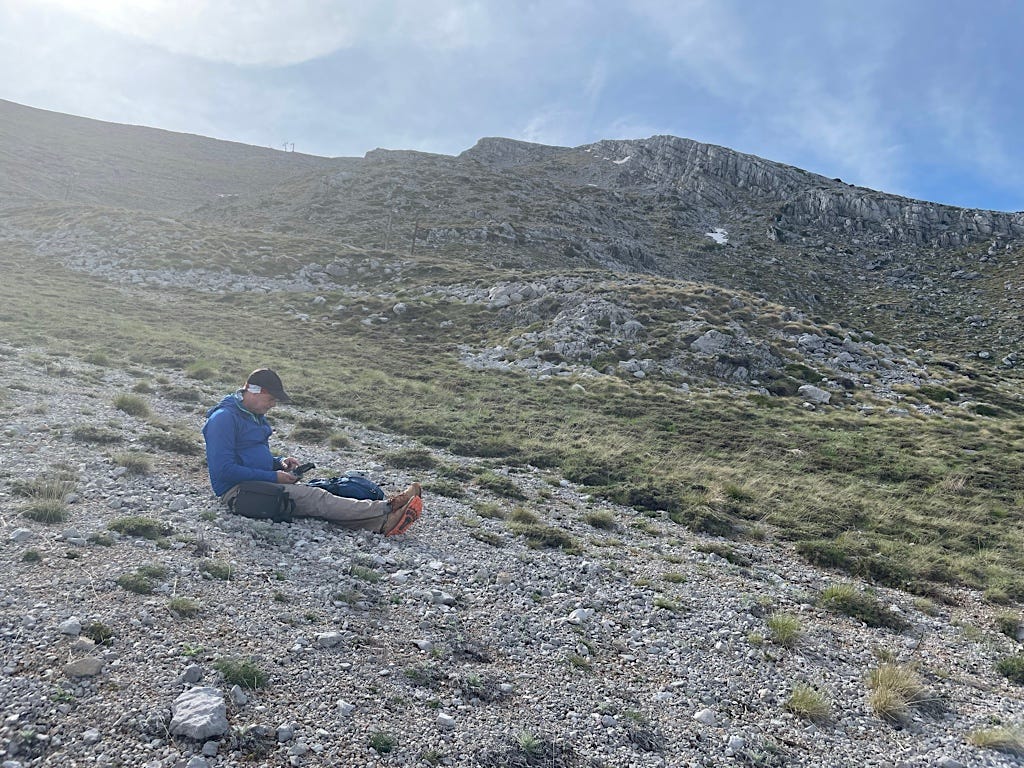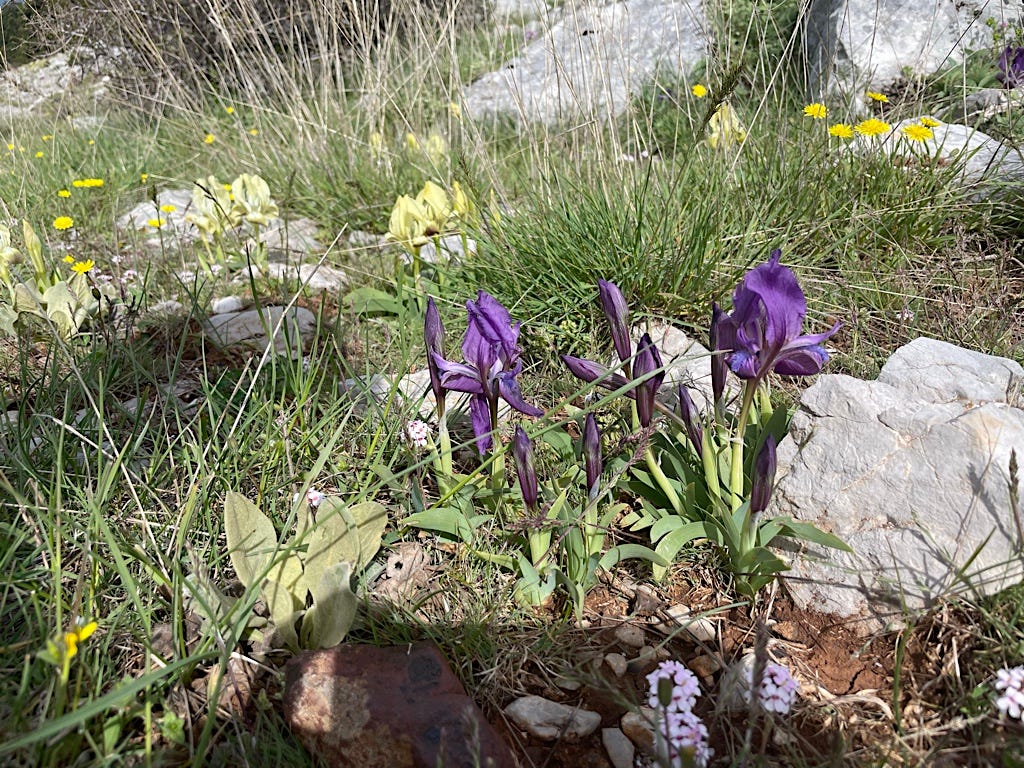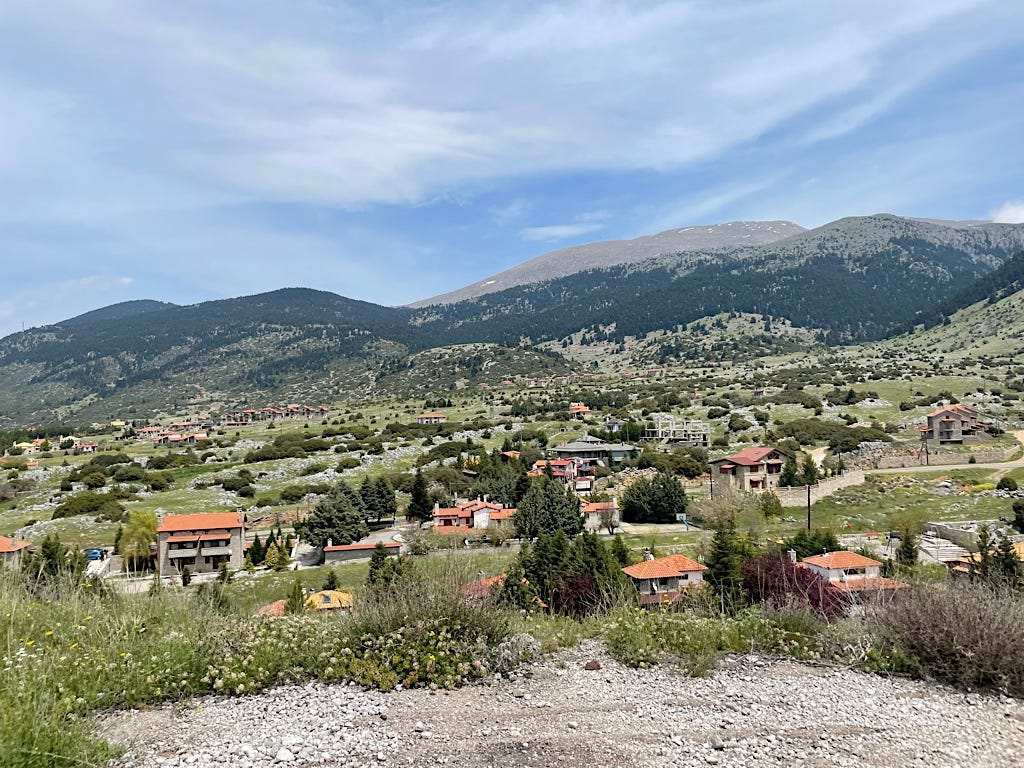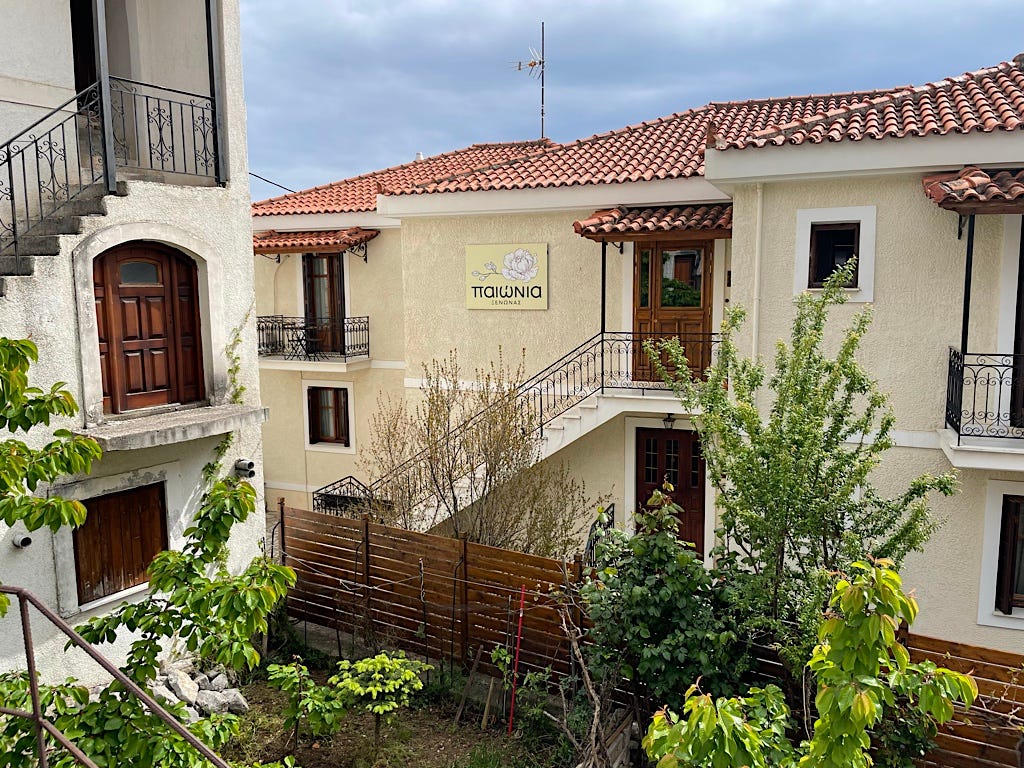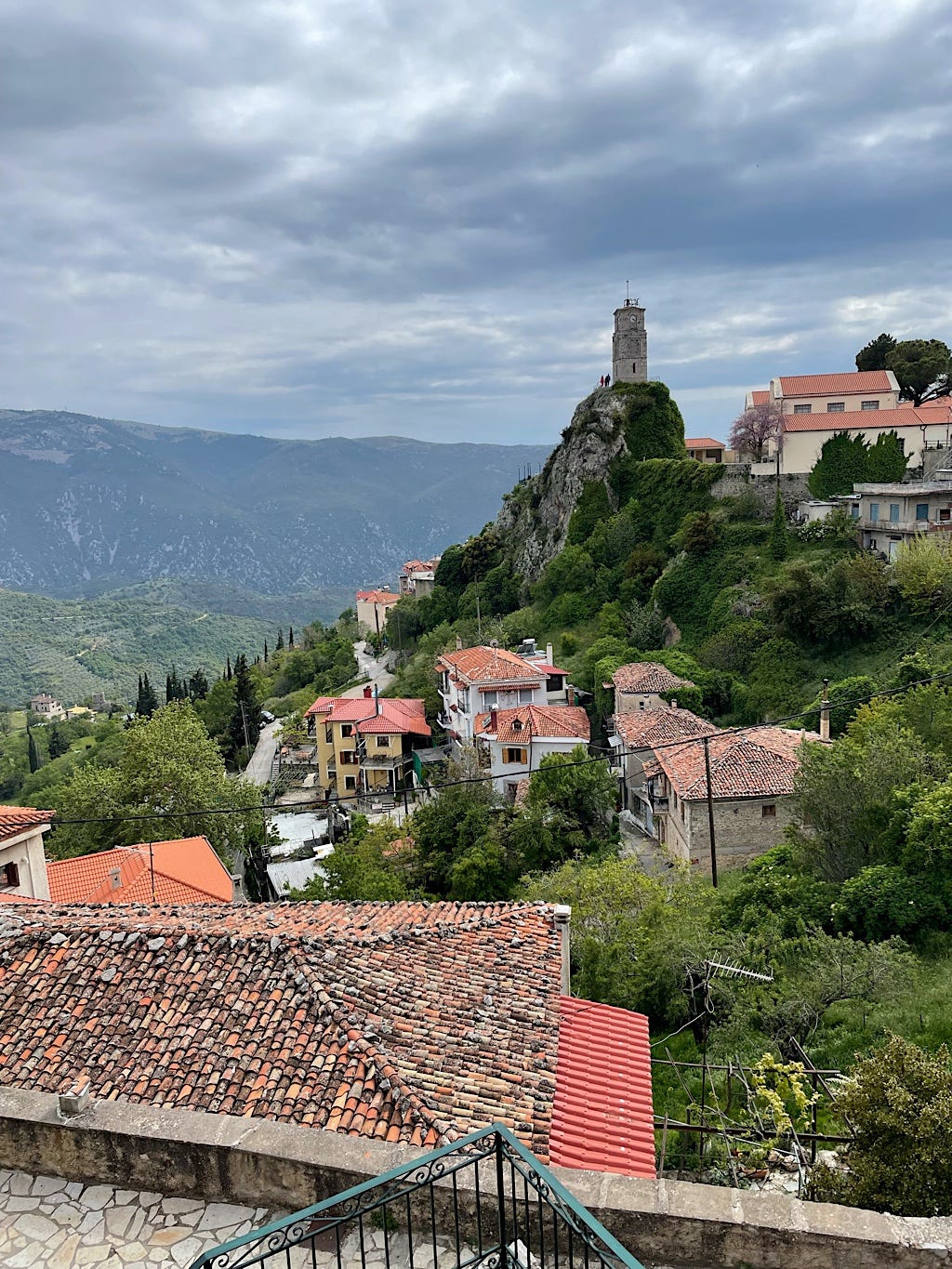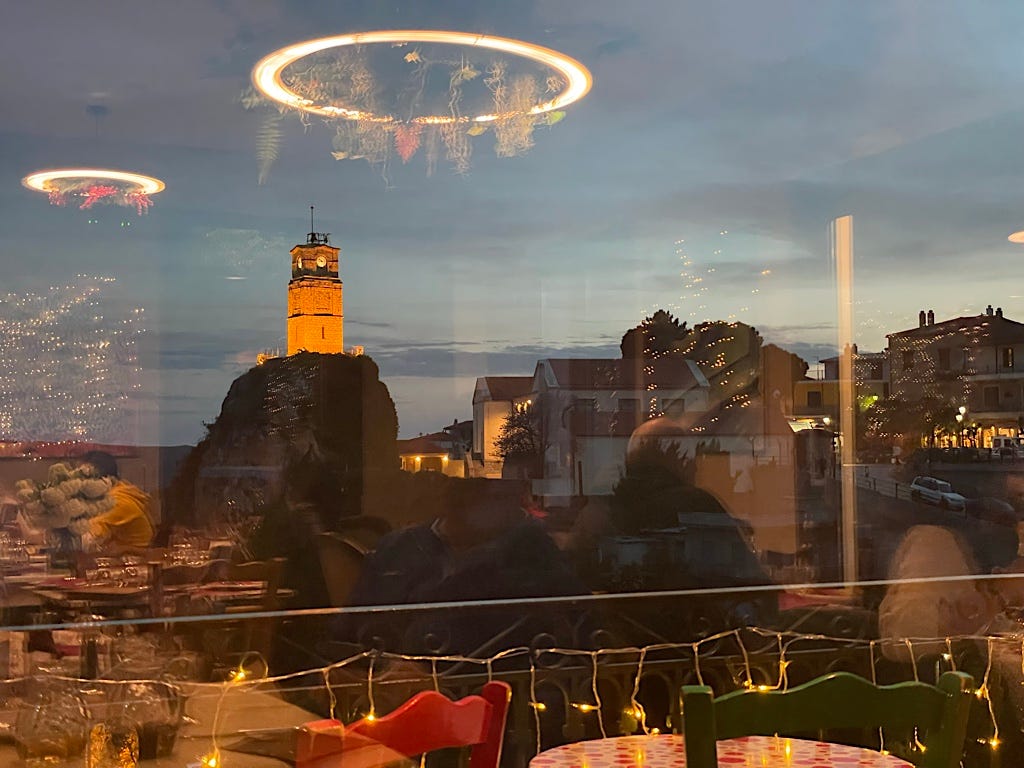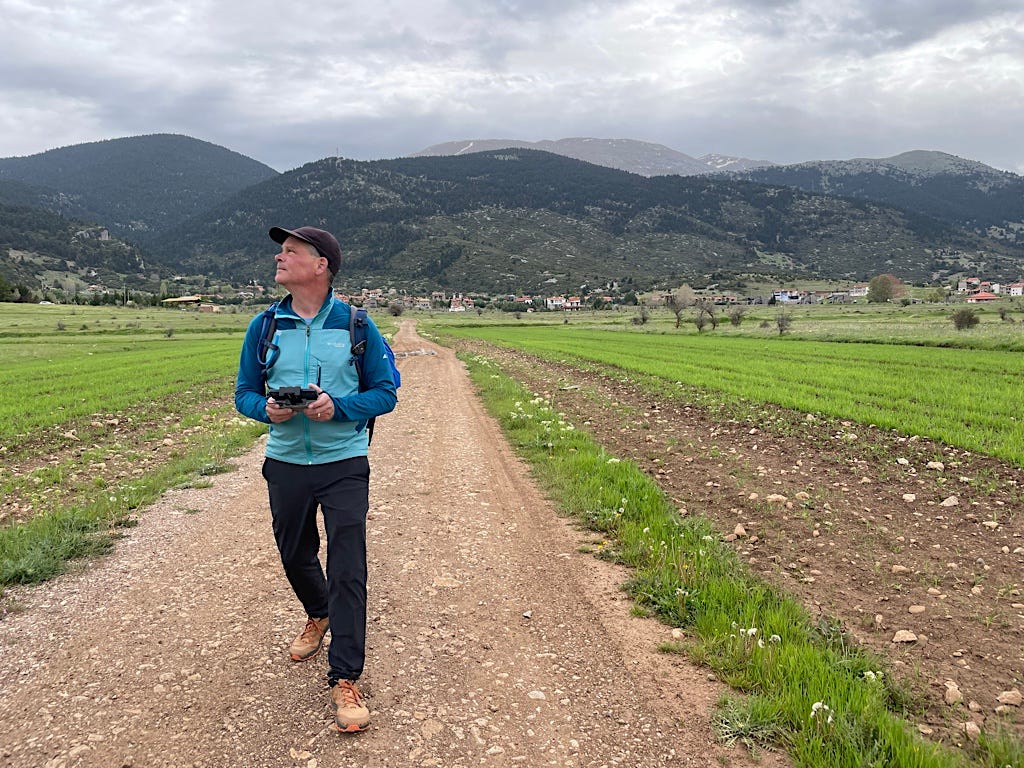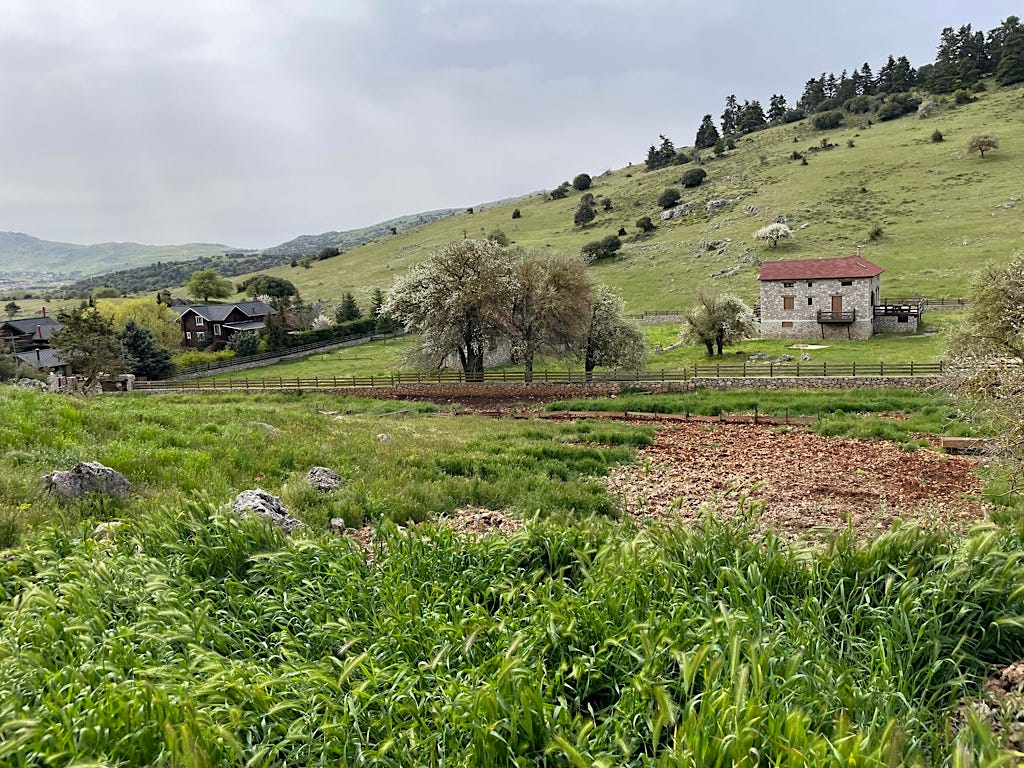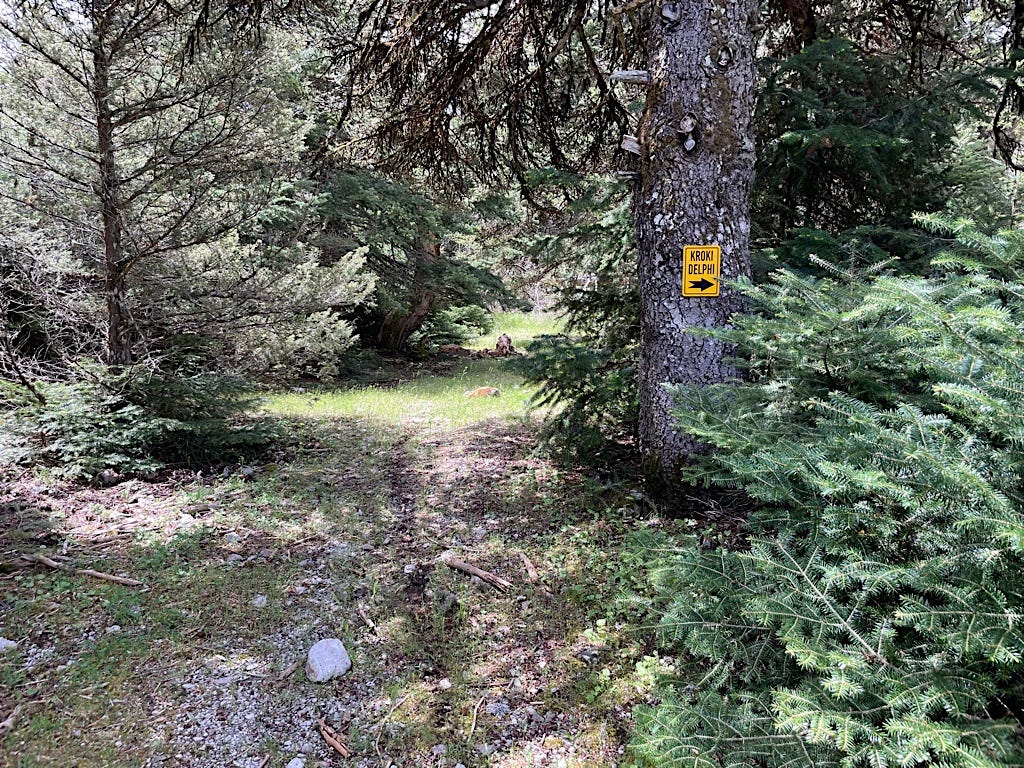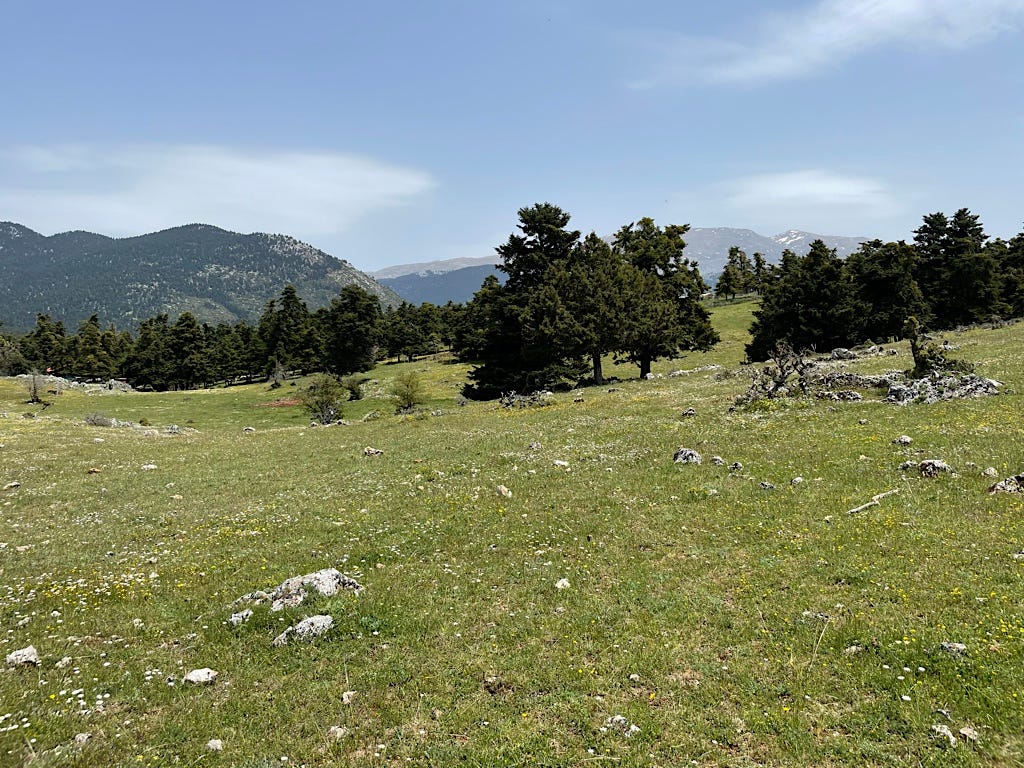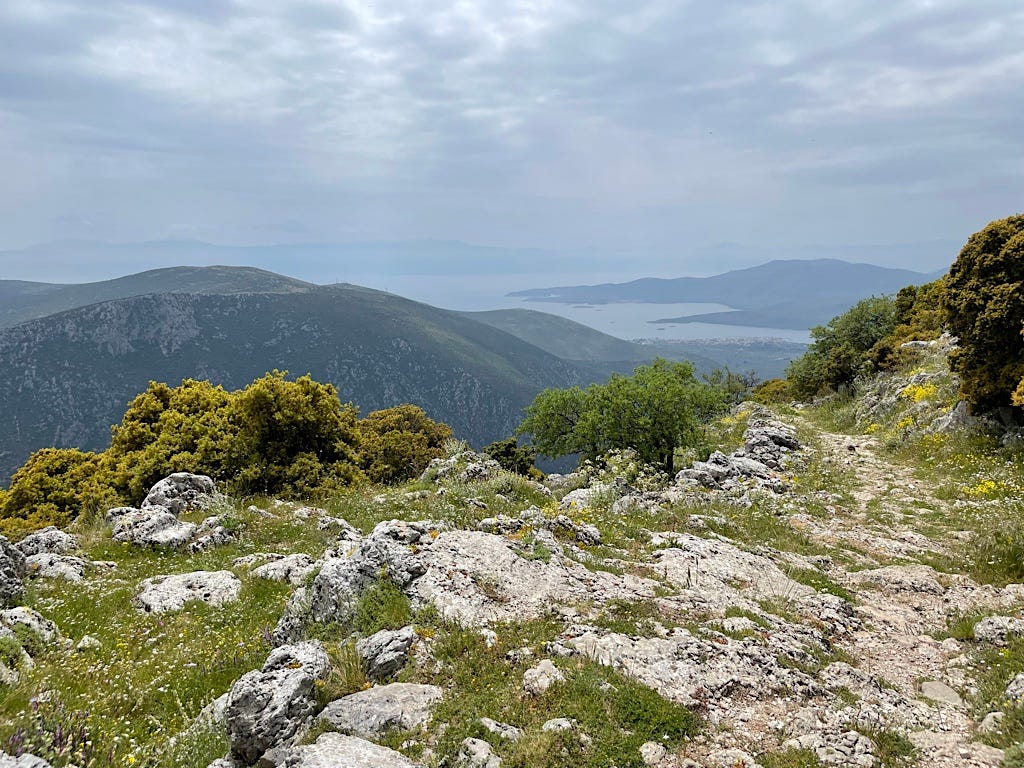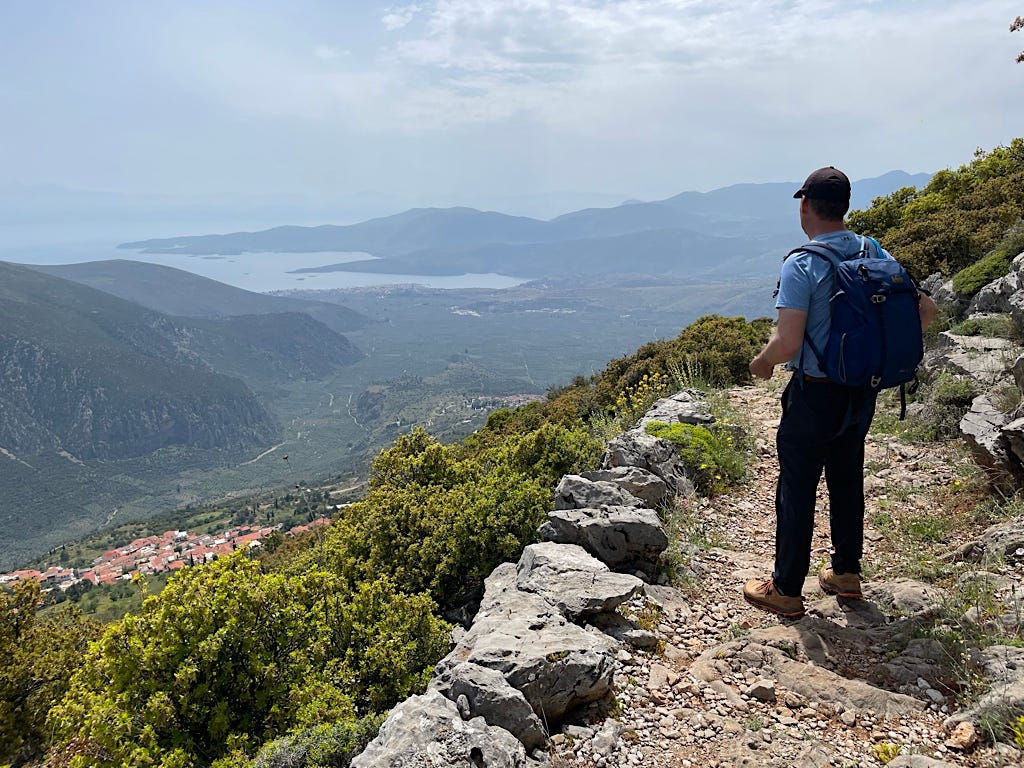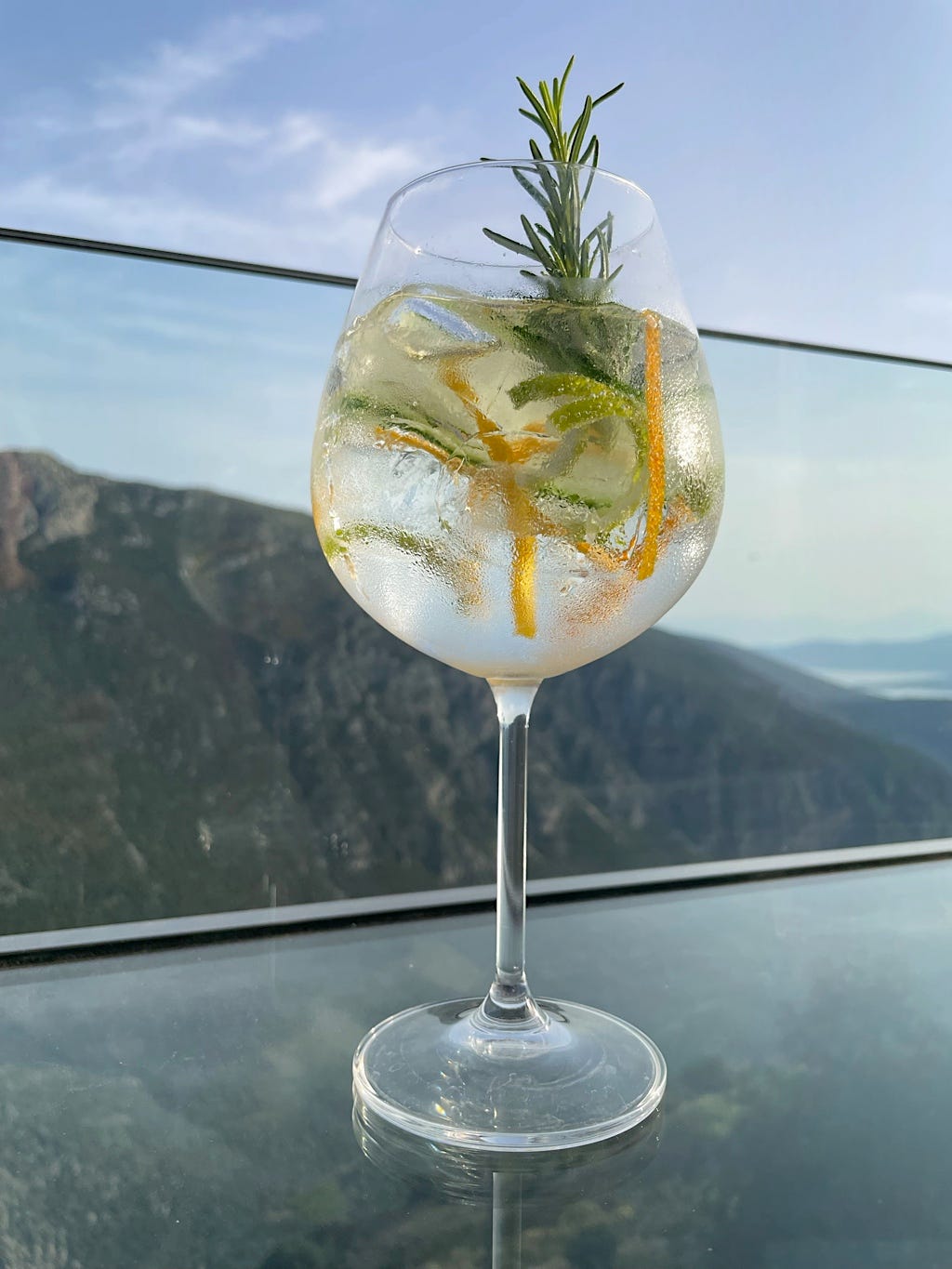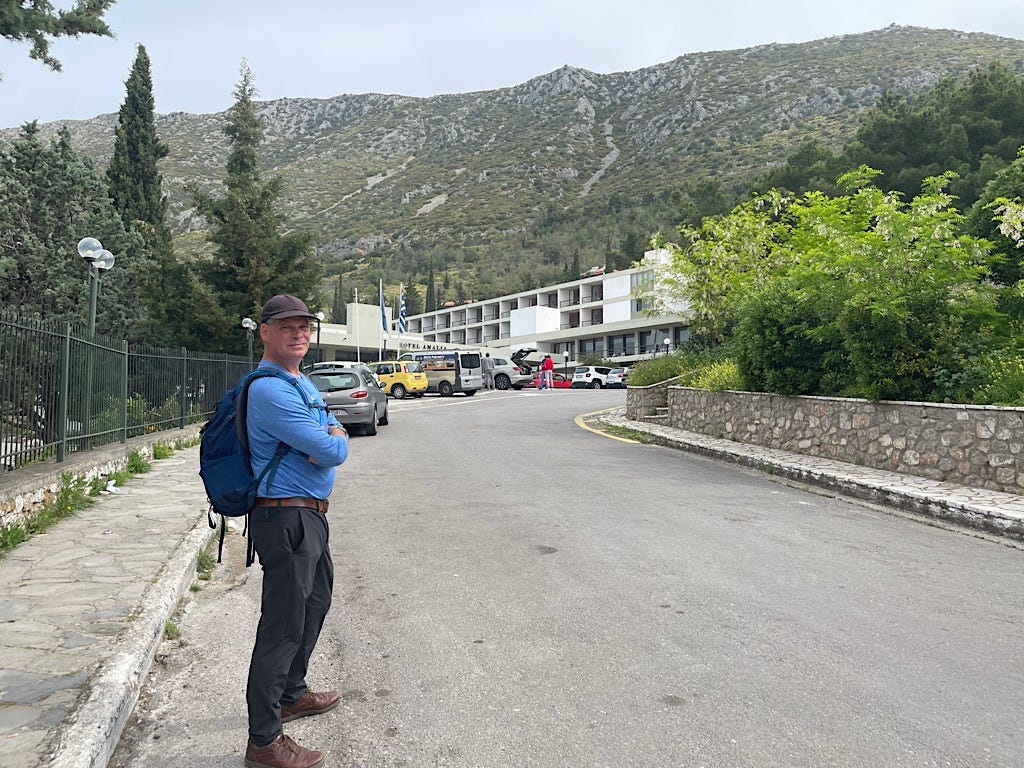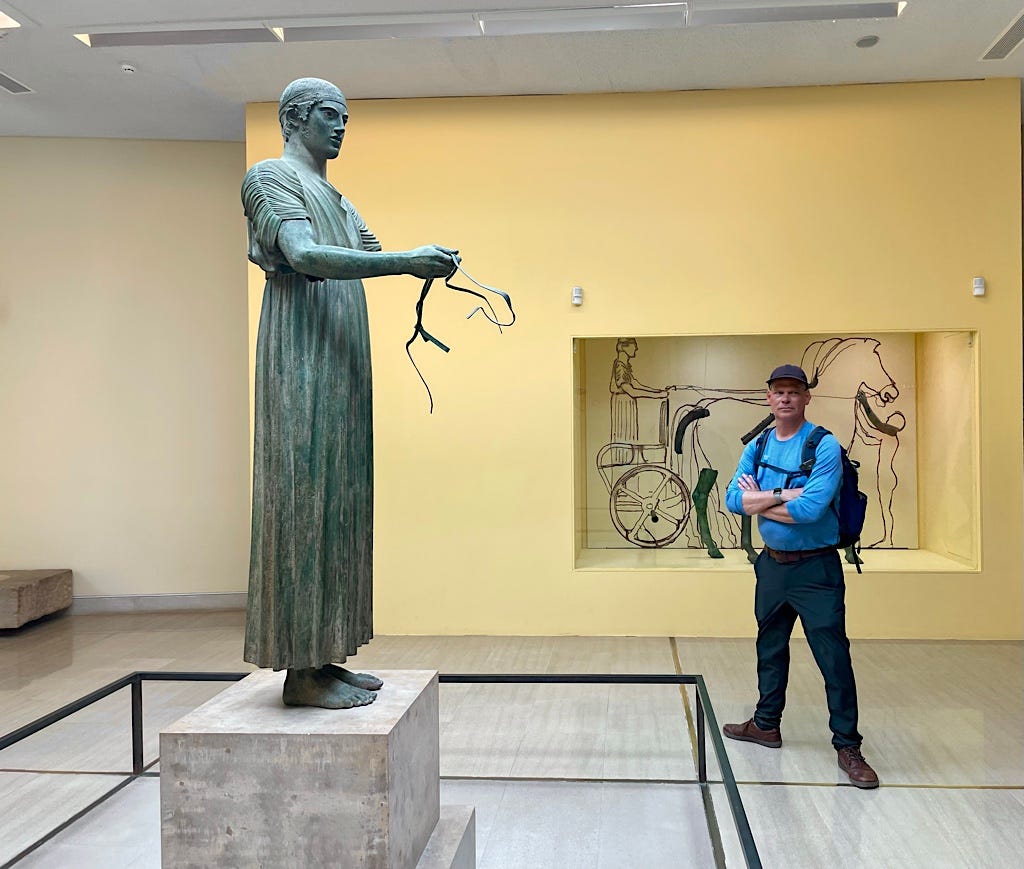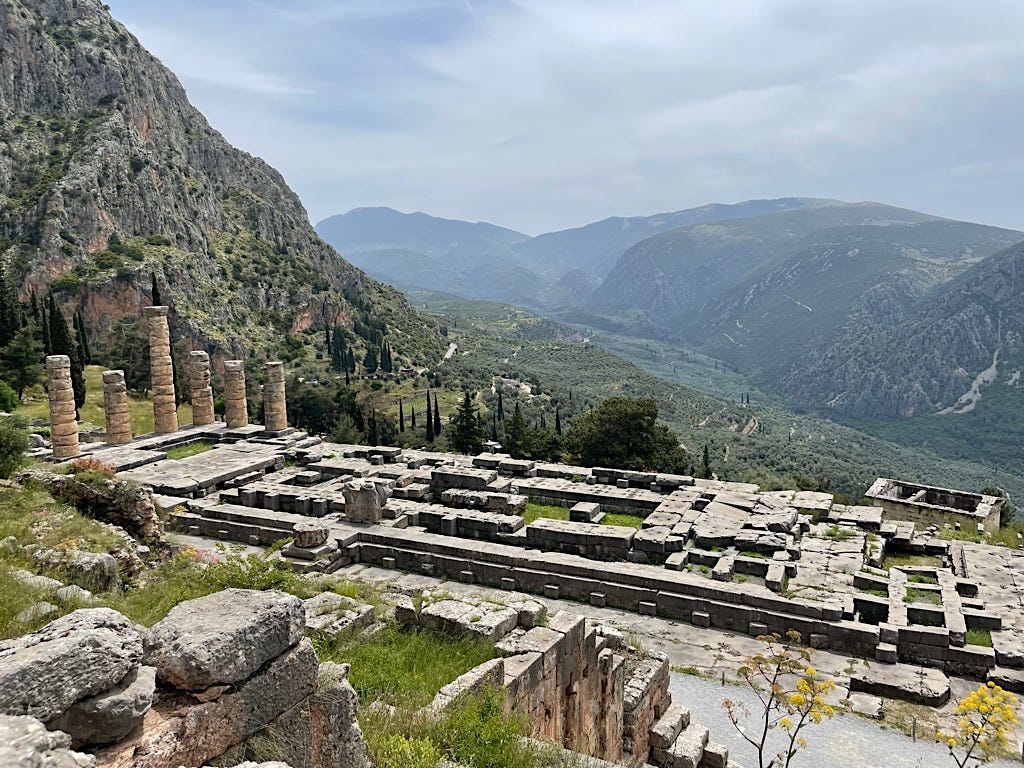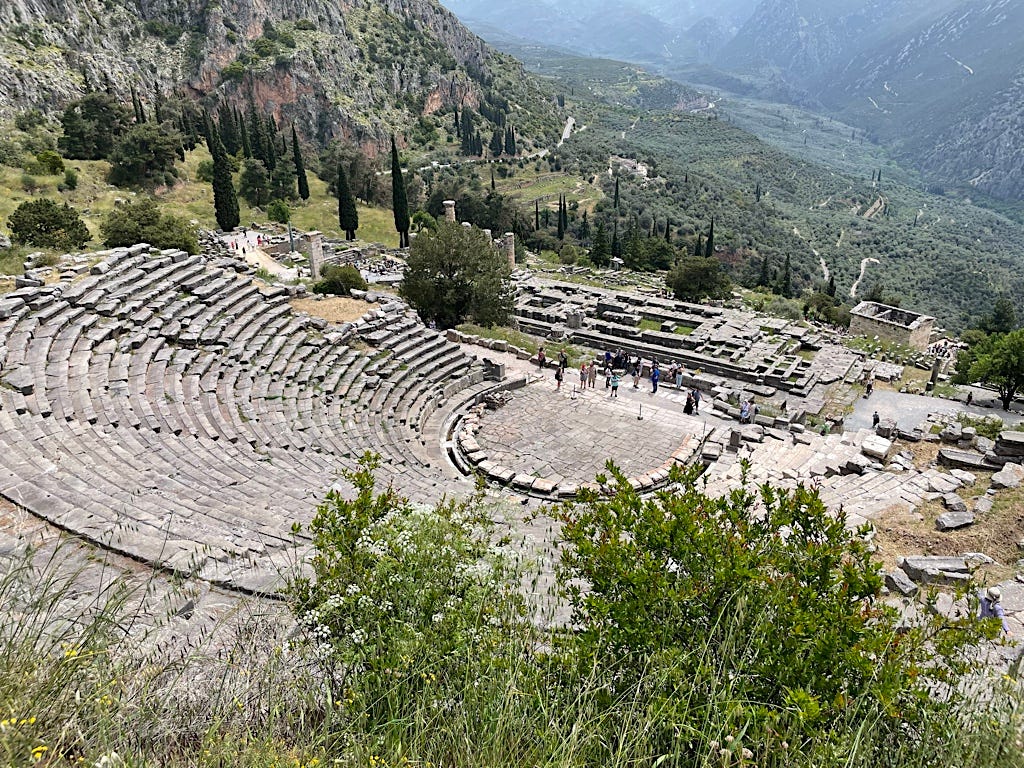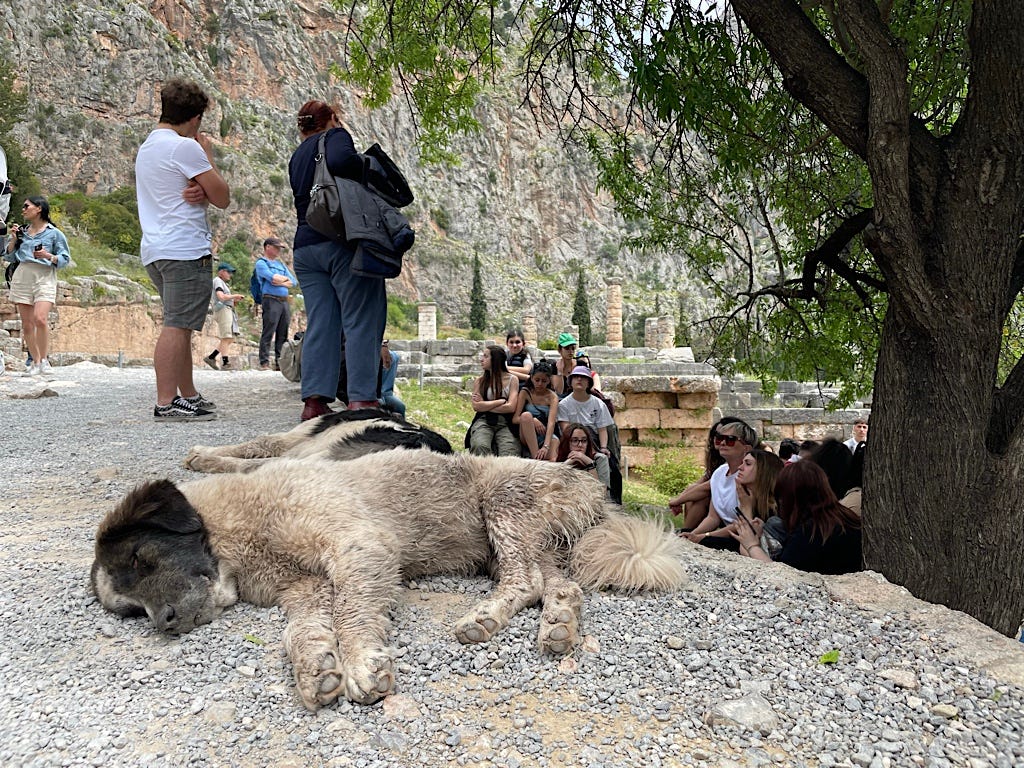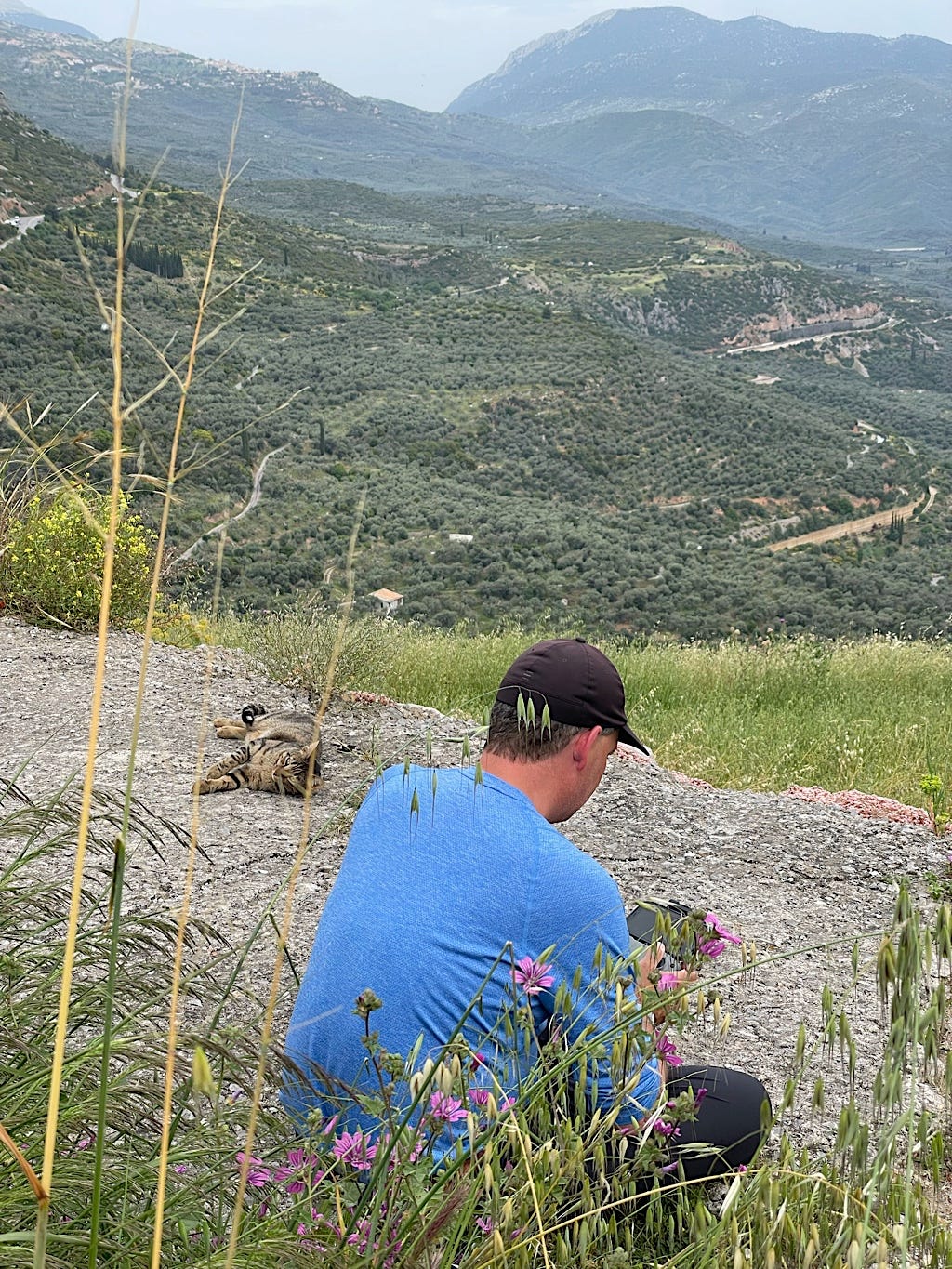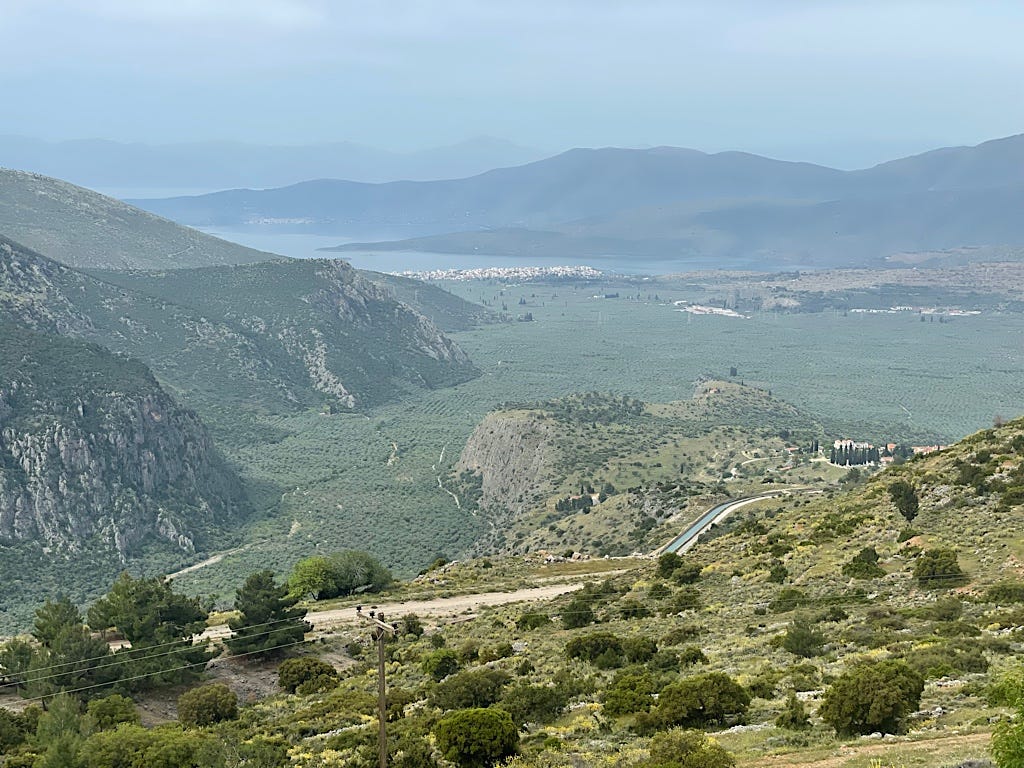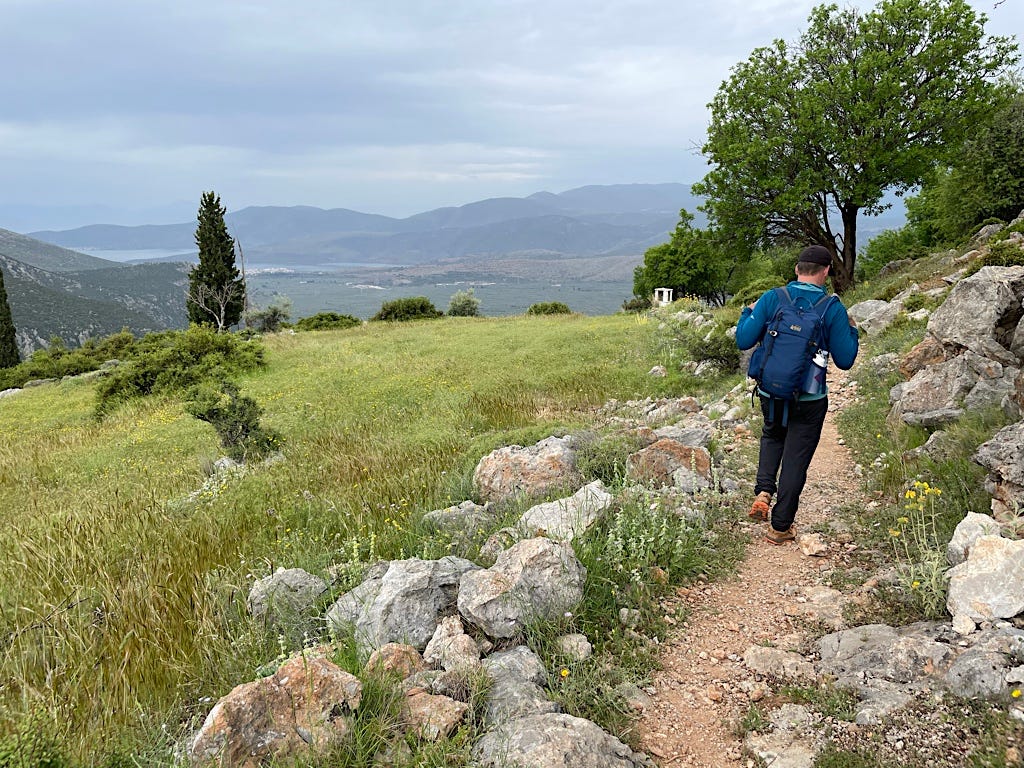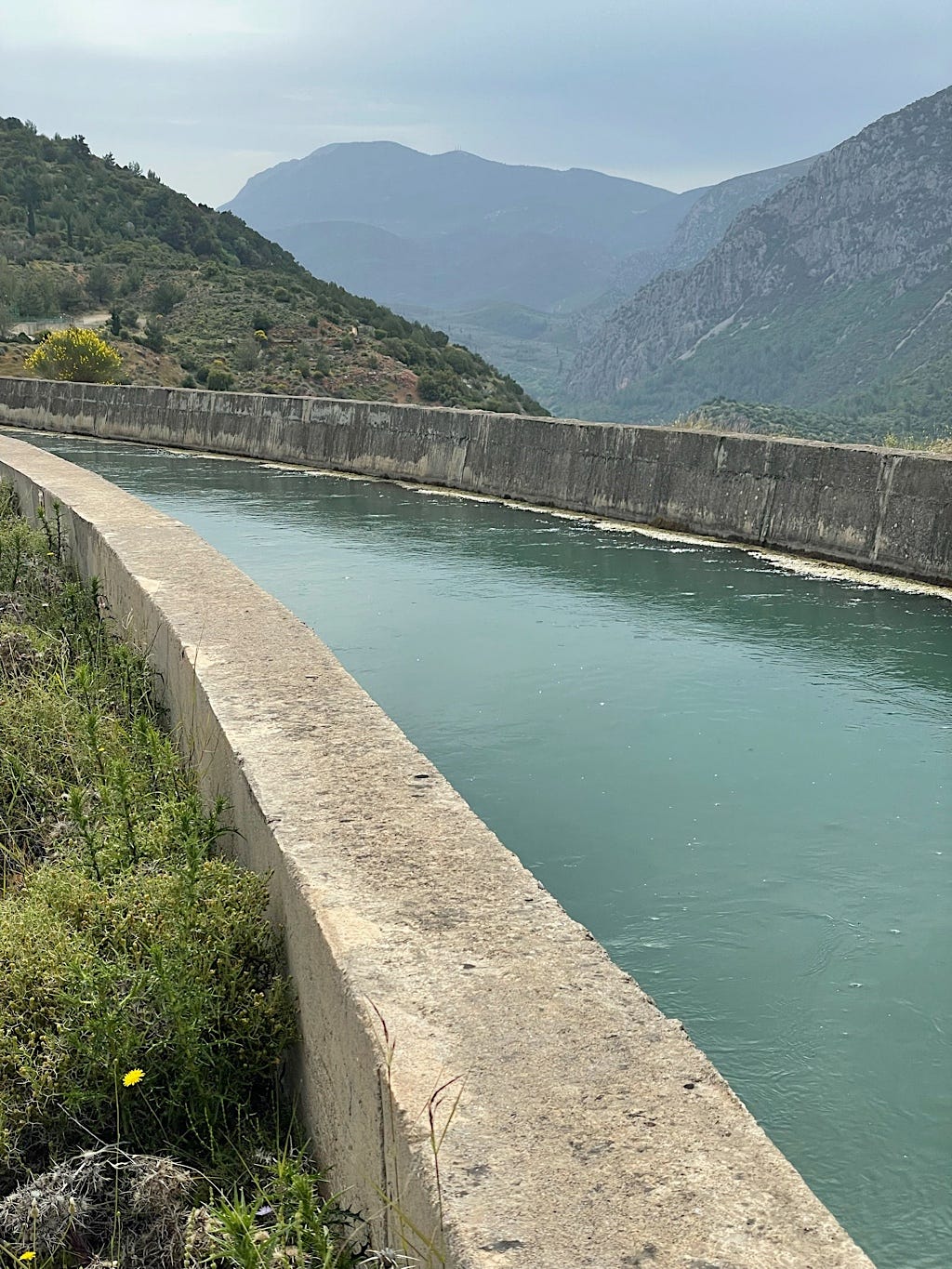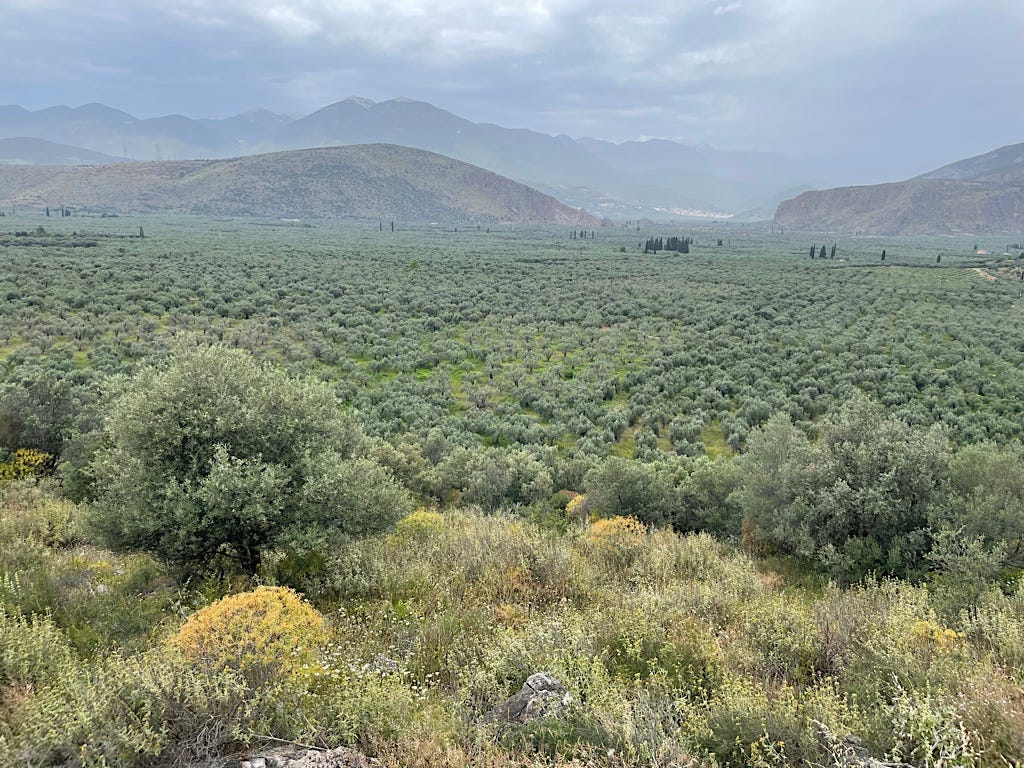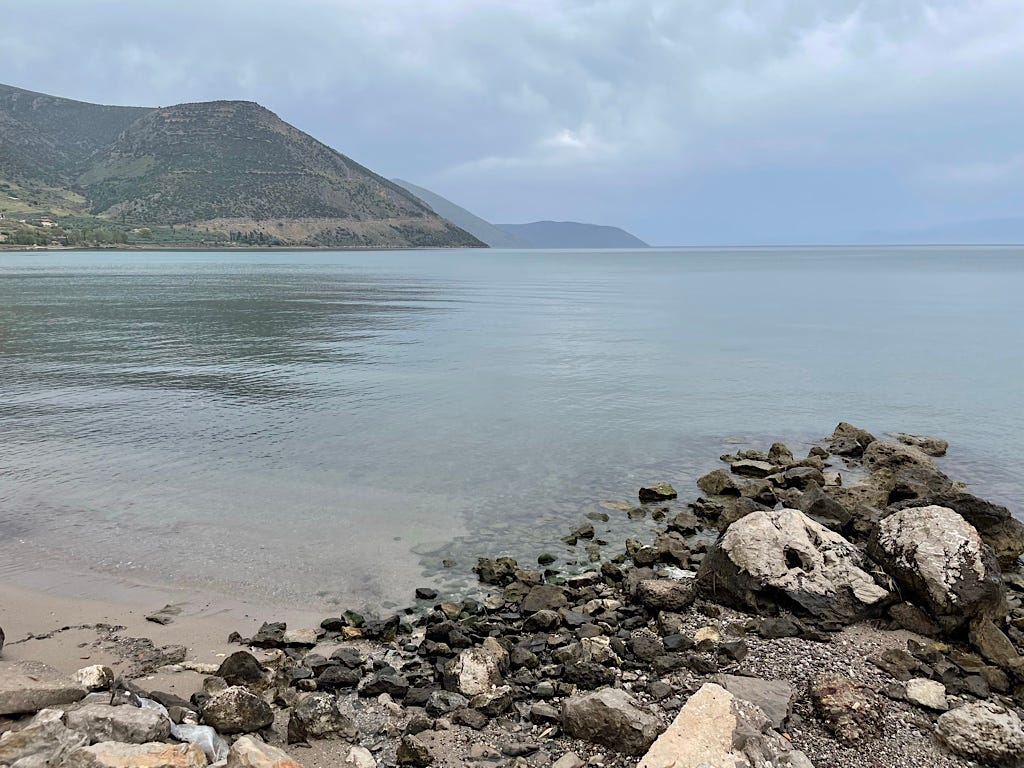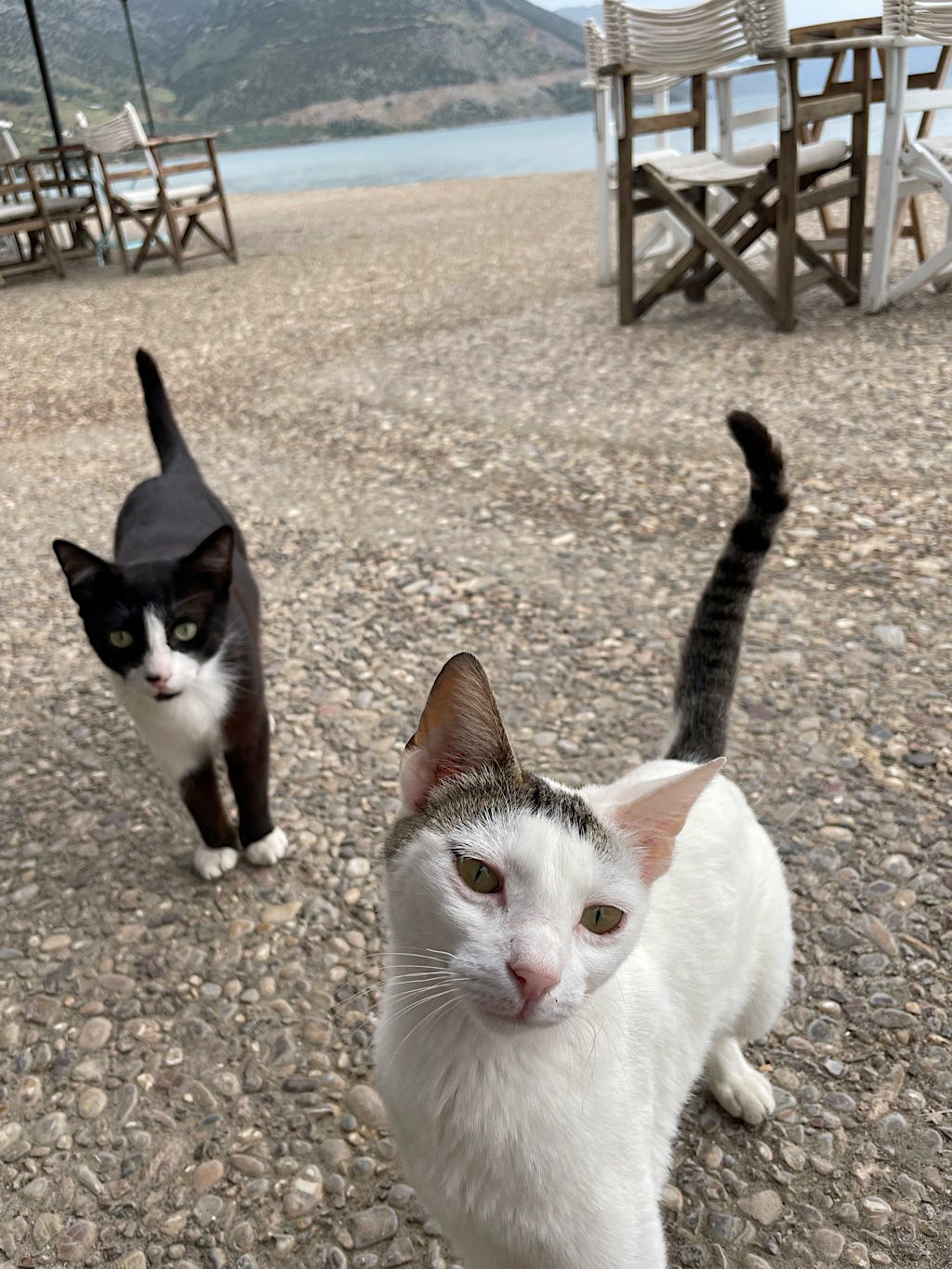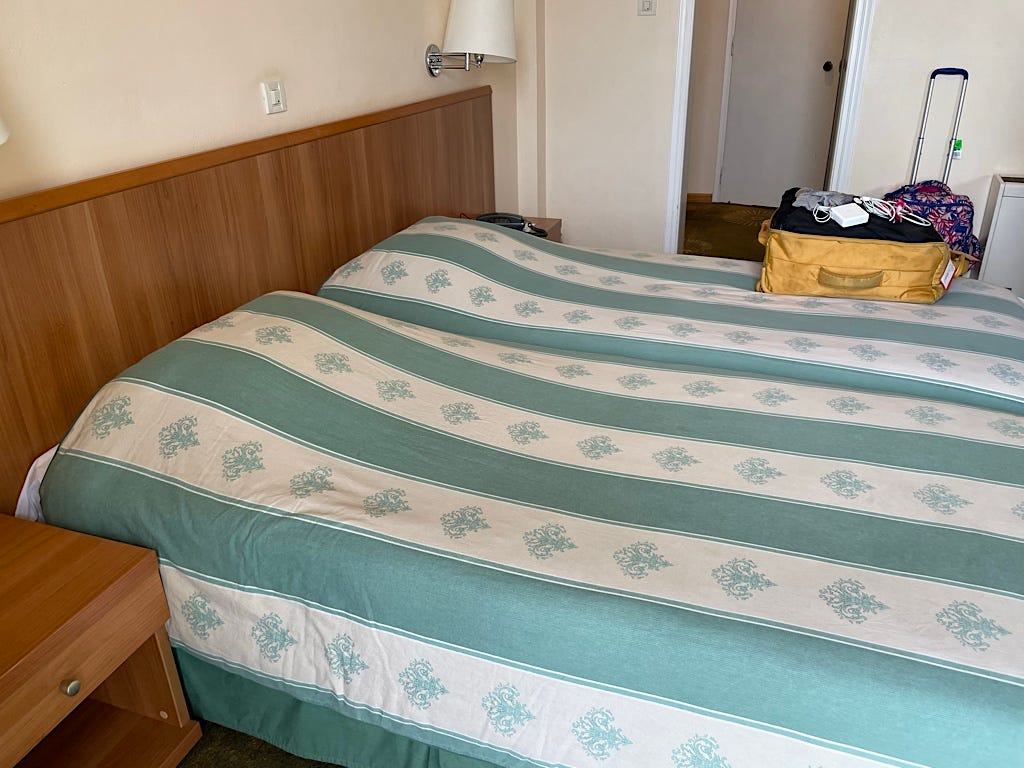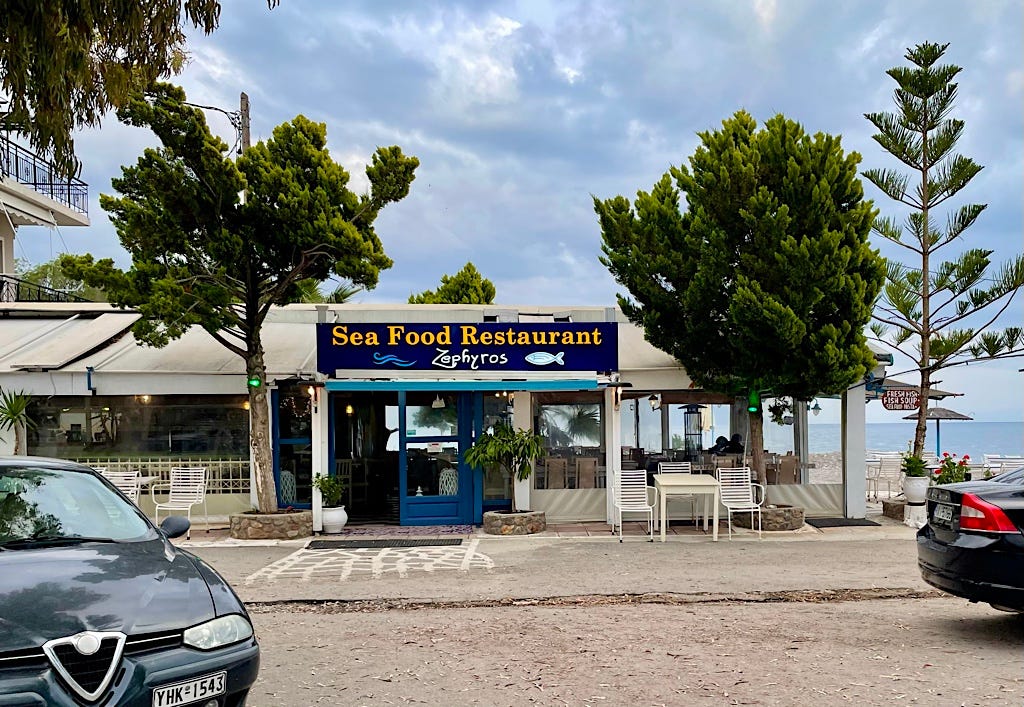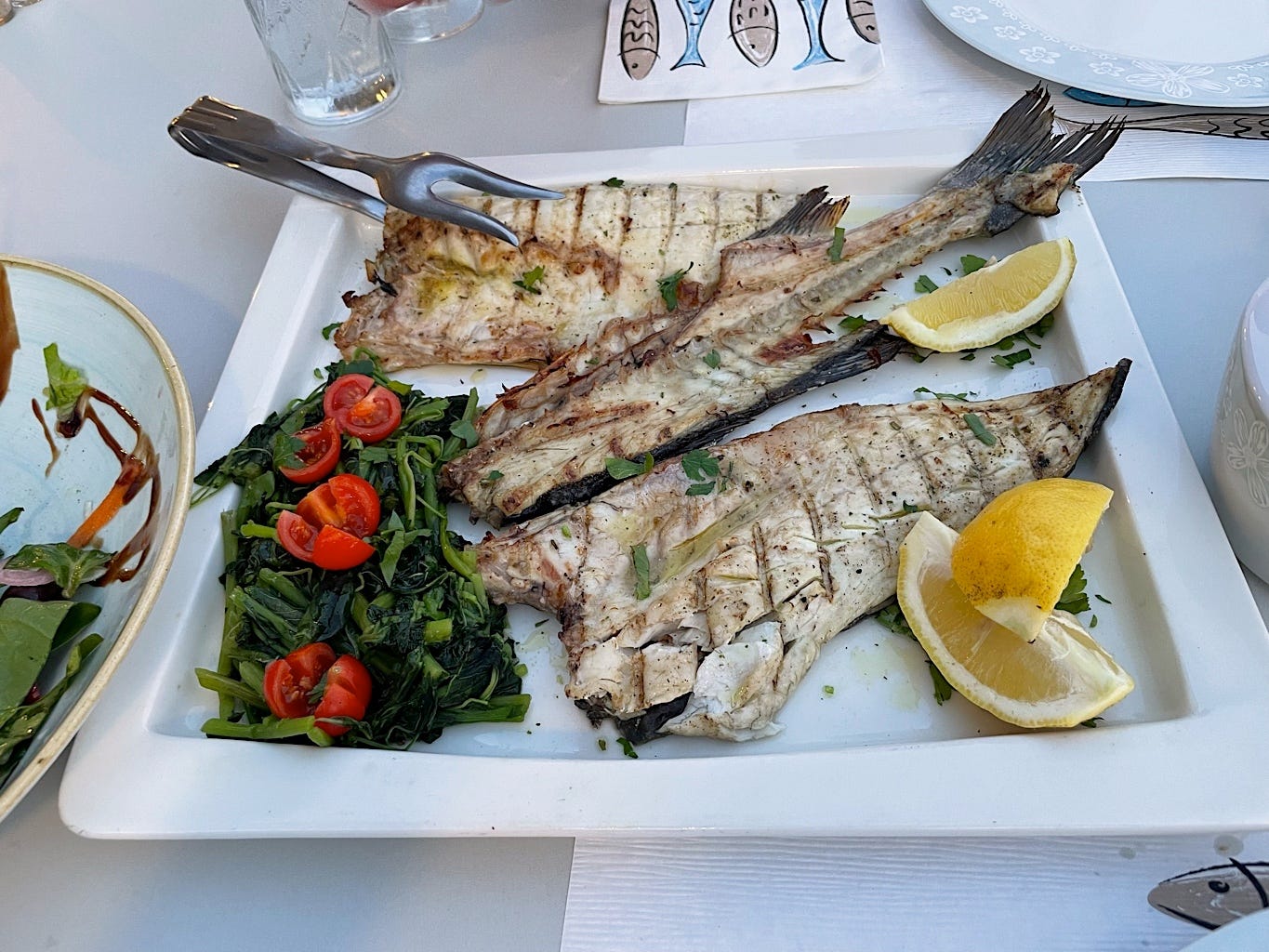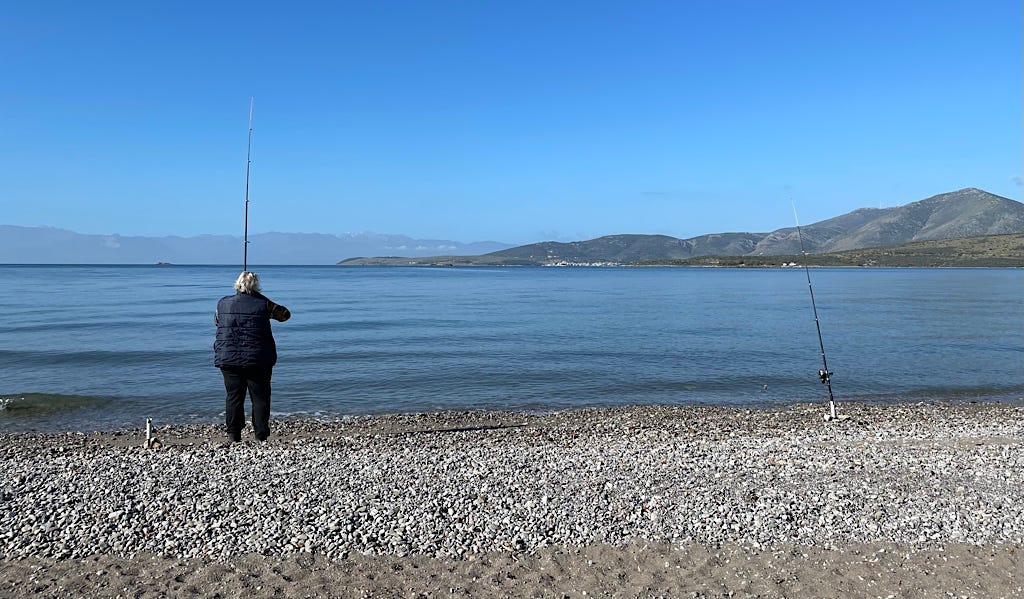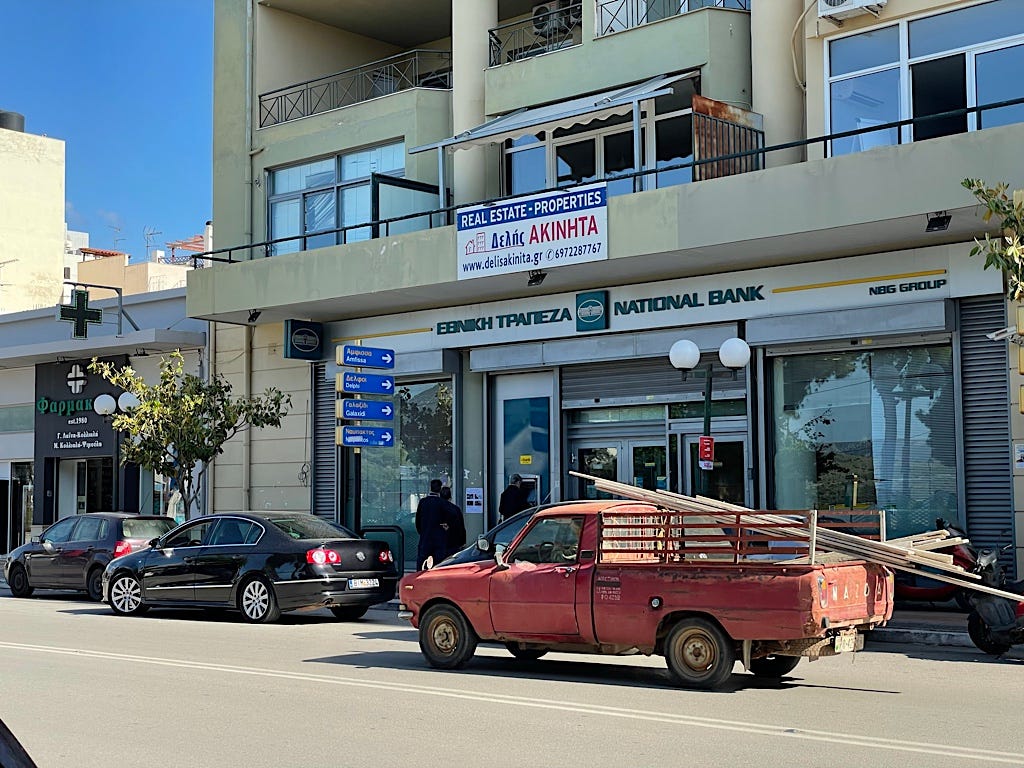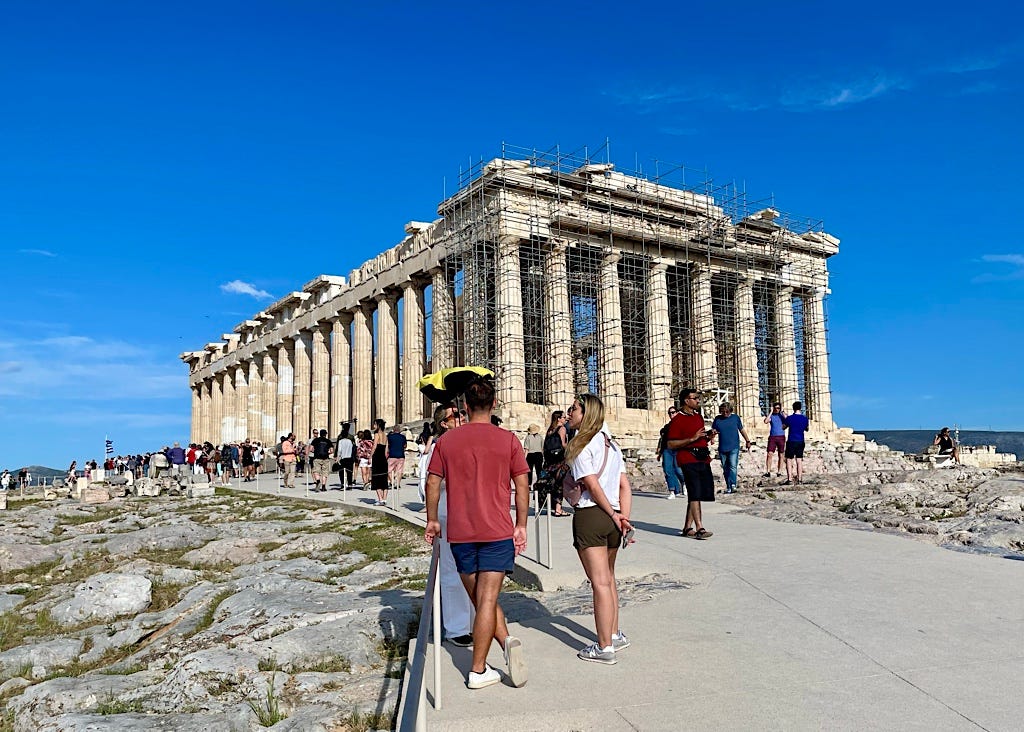Ancient Paths: May 10-17, 2023
— Amy G. Hackney Blackwell & Christopher Blackwell
This post is too long for email. To read the whole thing, click on the title!
We did our first multi-day hike in Greece in May, 2023.
We’d done lots of long-distance hikes in the Alps and in France, but never tried out Greece before. We weren’t even planning to go to Greece that year; we thought we’d do the Via Alpina in Switzerland a second time. But then our friend George Coundoussias announced that his son Demitri would be getting married in Rethymno, Crete, and who were we to stay away? To avoid having to make two trips to Europe that summer, I decided to see if we could duplicate the same sort of self-guided hikes with luggage transfer that we so enjoy in other parts of Europe.
And of course we could! Trekking Hellas organizes lots of multi-day treks, with routes all over Greece.
Since this was our first go, we chose to begin with the motherlode of Greek prehistory, the region around Delphi and Mount Parnassus. This was Trekking Hellas’ Ancient Paths trip, which they have since renamed to the somewhat less romantic “6 Days Delphi Trail–Paths 22 & E4.”
A good time!
May 10: Heraklion–Athens–Eptalofos
We started the day in Heraklion.
The previous week, we’d been to a wedding in Rethymno and then spent a few days visiting Kavousi in eastern Crete, where Amy worked on a dig back in 1990. We’d returned to Heraklion the previous day to see the town and meet up with our son and his wife before they flew back home.
We’d been using the services of a driver named Aristides to get around Crete. This morning, Aristides sent his wife to our hotel to take us to the airport, which was about five minutes away. Aristides himself had bigger fish to fry; as a long-distance taxi driver, he could make real money transporting tourists between cities instead of doing little jaunts to the airport.
Though the Heraklion airport is sometimes hailed as the worst airport in Europe, and some of our other passages through there have been decidedly godawful, today we had no trouble. We didn’t have to return a rental car, check-in didn’t take 90 minutes, and security was virtually empty. (Heraklion is due to have a new airport in 2027.)
We boarded our flight to Athens, but, as per usual, we had to sit on the tarmac for almost an hour before Athens air traffic control would allow our plane to take off. This seems to be standard now; I think it has to do with smog or something, or maybe they just have too much traffic. The Athens baggage claim was true to form as well, taking a good 40 minutes to produce anything.
But we finally emerged and greeted Giorgos and Stephanos, who had been waiting for us for the past hour. Also texting us, but I’d missed their messages.
Tip for American travellers: You need to get and use WhatsApp; that is what folks use (in our experience, from Greece to Nepal); we were looking at regular SMS and missing a lot of communications.
The Trekking Hellas van was parked in the lot right across from the terminal. We climbed in for the two-hour ride to the trek’s starting point, the town of Eptalafos.
After sunny Kavousi, the mainland was gray and cloudy. Crete had been cold for May, but the mountains of the mainland seemed to be still in winter. Concerned about my limited mountain wardrobe, I checked the weather forecast and discovered that evening temperatures would be in the 30s! I briefly wondered if I might freeze to death on Mount Parnassus.
As we drove past Thebes, Giorgos pointed out the spot where Oedipus met and killed his father.
The winding mountain roads were socked in with mist. We passed through the town of Arachova, which was packed with tourist buses even in early May. And then we were in Eptalofos. It’s also known as Agoriani; it’s a good idea to commit both names to memory, because local people will use either one.
Misty mountain town Eptalafos.
Eptalafos (the name means “Seven Hills”) appeared deserted except for Alexandra, owner of Guesthouse Alexandra. We told her that we planned to eat at a restaurant in town. She shook her head dubiously. Maybe it would be difficult, she said. When a Greek person says “maybe” and “difficult,” she means “definitely” and “impossible.”
Because we are optimists, and also because we’d sat on our butts all day and had nothing better to do, we ventured out to explore the town and prove Alexandra wrong.
The sign over the river says “Agoriani.”
This big tree has a fountain in it.
Alexandra wasn’t exaggerating. All the shops were indeed closed.
As we stood outside one restaurant, pondering the menu and debating whether it might open in an hour or so, an old man stopped and regarded us. “Mangiare?” he said. “Yes!” we replied. “No!” he answered, giggling as he walked away.
At least that was helpful.
At that moment, Alexandra emerged from the mist on her scooter. She was on her way home, but she’d left food for us to eat in the kitchen. We were to treat the guesthouse as if it were our own home.
Since we’d pretty much exhausted the entertainment value of Eptalafos, and it was cold, we went back inside to see what we had for dinner. At this point, we realized we weren’t just the only guests at Guesthouse Alexandra; we were the only people, period.
Alexandra had cooked some Barilla penne with Barilla tomato sauce. She’d left out a couple of salads and a block of feta cheese. It was a fine meal! We ate, washed the dishes, and then raided the kitchen cabinets for anything entertaining. We found some Campari and a bottle of Beefeater with about an inch left in it. Mixed with tap water, this made a passable if austere negroni. Chris lit the fire in the large, empty living room. We were huddled up in armchairs when Alexandra returned with paper towels. She expressed astonishment that we had washed the dishes, but we pointed out that she said to make ourselves at home, and this is what we do at home.
Alexandra and Giorgos both agreed that these mountain towns have a balance problem. Eptalafos is either completely slammed with tourists, such that no one can move, or completely deserted. Guesthouse Alexandra is huge, with space for dozens of guests, which suggests that Alexandra must sometimes have to accommodate loads of tourists. Maybe they stay there during ski season? But much of the year, there aren’t enough visitors to even cover the expense of turning on the heat.
May 11: Polydrosos
The day dawned drizzly. Alexandra set out a lovely breakfast, including especially good fresh yogurt with a creamy skin atop in a clay pot. (This type of yogurt is available in most Greek grocery stores–I highly recommend it if you can find it!)
We packed up to head off on our first day of hiking, laden with the lunch Alexandra packed for us. We started in town, but quickly found ourselves in the countryside.
The trail starts in Eptalafos.
The road to Polydrosos.
We encountered mean dogs.
It didn’t take long for us to leave the town and enter genuine countryside. The trail looked as if no one had yet walked it this season. Greece doesn’t have the same hiking culture as places like Switzerland, and trails aren’t as obviously used and maintained.
Much of the trail was through plants and over rough rocks.
The scenery around Mount Parnassos is stunning!
Late in the afternoon, we arrived at Guesthouse Sofiana, where we were greeted by Mrs. Fifi. Once again, we were the only guests in a rather large establishment. Once again, the heat wasn’t on when we arrived, though Mrs. Fifi did turn on the radiators for us.
That evening, we ventured out in a drizzle to see what Polydrosos has to offer. The answer was: slightly more than Eptalafos, but not much more.
Lively town.
Chris ripped his Mountain Hardwear Ghost Whisperer on a chain-link fence. The feathers were in danger of escaping, which would’ve been a problem the next night on Mount Parnassus. We found a pharmacy, where the pharmacist sold us some bandage tape.
Sitting outside on a drizzly day can be chilly.
We found a likely looking restaurant, or at least a restaurant that appeared to be open, though no one was dining there. It claimed to sell wild boar dishes.
The decor was informed by local hunting culture.
Since we had our choice of tables, we selected one by a window overlooking the misty valley. The proprietor tore himself away from political television (it was election season, and the conservatives were coming in strong) to take our order. When we asked to see a menu, he shrugged but gave us one anyway. The reason for the shrug became clear as we deciphered the Greek and asked for things, to each of which he replied, “No.”
Finally we asked him what he did have. “Souvlaki. Patates. Horiatiki.” So we ordered souvlaki and French fries and horiatiki. The horiatiki arrived cold from the fridge where it must have been sitting for hours. The French fries were soggy with grease. The souvlaki came from the souvlaki stand next door. After serving us, the man went back to lurk by his television.
Ah well! It was worth paying to sit at a table with a view out of the rain, and at least there WAS a restaurant!
The view was stellar anyway.
Polydrosos is another of these mountain towns that seems to be developing a tourist industry, partly in response the the development of ski resorts on Mount Parnassus, but that is either on or off, nothing in between. There’s a winery there that specializes in some old local varietals. I imagine the town square is hopping in summertime.
May 12: Mount Parnassus
Mrs. Fifi laid out a breakfast spread sufficient to serve a full dining room of guests. For just the two of us. Her super fresh spinach pies were dripping butter, so good. I worried about getting fat, but today’s hike (17 kilometers!) seemed unlikely to present options for lunch, so it would probably balance out. She warned us that there might be mean dogs on the path to Mt. Parnassus.
Mrs. Fifi insisted that Chris carry this stick to ward off dogs.
Today, instead of traveling from town to town as usual, we were climbing up a mountain. Mount Parnassus, to be exact–once the haunt of gods and nymphs and now a popular ski resort. Instead of staying in a hotel, we’d be sleeping in a mountain hut. More on that in a bit.
The walk out of Polydrosos was pretty. Athenians have started buying up weekend cottages in the area, but just out of town you get into farmland and forest with no hint of nearby urbanites.
Flowers grow right out of the rock walls!
It’s pretty here.
Chris filled his blivet from a farmer’s fountain.
Trekking Hellas has always been clear about the necessity of navigation for self-guided hikers. They send meticulously curated GPX files, but those GPX tracks don’t always follow the obvious trails, and Greek trails aren’t always obvious. This was definitely the case as we got higher up the mountain and further into the piney woods. At one point, we found ourselves nearly crawling under pine branches up a slope; I’m still not sure that was right, though Chris insisted that this was what our GPX trailblazer had done. The way the GPX works is this: If the pioneer made a bad decision, you’re going to make it too!
This is a very rocky walk.
If the mist gets thicker, the barrow wights will emerge.
Fritillaria growing in the high-altitude rocks.
The last part of the trail to Defner Mountain Hut goes across several ski slopes with their accompanying dirt service roads. The terrain got even rocker underfoot, if such a thing was possible. The last part of this hike seemed interminable. We kept thinking, “Surely we are almost there!” And we kept being wrong.
We’re right on up there!
We were pretty tired by the time we arrived at Defner Mountain Hut.
For those of you who are unfamiliar with the term “mountain hut,” I will now explain. Huts are a big part of mountaineering and high trekking culture. They aren’t “huts” in the Appalachian Trail sense of a tumble-down shack that can provide a roof and (maybe) four walls, perhaps with bunks and vomit-stained mattresses, and bees, but nothing in the way of amenities such as a dining room or running water. Instead, they are small hostels with beds for a number of people, toilets and sinks, often showers, and kitchens and dining rooms. Huts are everywhere in the Alps, where they provide inexpensive shelter and camaraderie for long-distance trekkers who want to sleep (or just eat) high in the mountains.
Amenities vary. A few modern huts have private rooms and en suite bathrooms. Others have large rooms of bunk beds and shared bathrooms, like dorms. Still others place mattresses on platforms, and guests pile in next to one another. Cozy. The point is simply to have a warm, sheltered place to sleep while participating in vigorous, high-altitude activity. You don’t come to a hut seeking luxury. Or privacy.
Defner Mountain Hut on Parnassus is on the bare-bones end of huts but is also extremely hospitable. Our host, Kostis, greeted us with enthusiasm but in a hushed voice. When we arrived, the dining tables were full of trainee mountain guides taking a mountain navigation test, and he didn’t want to disturb them.
Kostis showed us the amenities. Just inside the exterior door is the kitchen and one dining room. This room has several tables with long benches that double as beds at night. At the far end of the dining room were the lavatories, with four toilets and sinks. The south side of the hut contains a sort of sun porch, a narrow room with several smaller tables walled all around with windows looking out across the hills toward the Gulf of Corinth.
Defner hut has one bedroom with two twin beds against the walls and then a sort of double-layer mattress platform loft, with mattresses above and below. Kostis gave us the loft all to ourselves–luxury, considering that there was space for a good five or six people! The loft contained several filthy mattresses, quilts, and pillows. We’d brought sleeping bag liner sacks to put ourselves in, but there’s really no way to avoid contact with much-used bedding in these situations. At least we didn’t have to snuggle with strangers.
Our suitcases had been transported to the hut, which we hadn’t expected and which wasn’t necessary; they took up limited space, and we really didn’t need our computers and formalwear from the previous week’s wedding up on the mountain.
Though some Alpine huts can be reached only on foot or by helicopter, it’s possible to drive to Defner on a dirt road. Plenty of people drive up there just to enjoy a meal in the mountains and do some light hiking from there.
Some folks pitch tents by the hut. They can use the facilities and maybe enjoy a beer, but they sleep outside instead of bunking down with everyone else.
We arrived at about 4:00. Dinner wasn’t until 7. Kostis offered to make me a snack, and I realized I was ravenously hungry. He quickly fried up a couple of local sausages, which I ate in complete silence while the would-be guides fretted with their paper maps and compasses.
The most delicious snack ever, including the beer, which I almost never drink!
Chris flew his drone at golden hour. It was cold and windy!
Back indoors, it was time for dinner. Kostis served everyone the same thing; that’s the deal with huts. After we ate, we sat and talked with some of the guides. The leader was a German who had come to train new Greek guides, part of Greece’s effort to up its outdoor tourism game. We had a great time until Kostis cut off the power at 10. That’s also standard hut practice; electricity requires a generator, which requires fuel. Anyone who stays in a hut overnight is well advised to bring a headlamp or at least a flashlight.
Chris and I climbed up to our loft and slid into our sleeping bag liners. Maybe four other guys were sleeping below us. The room was heated with a woodstove, which created a soft red light all night and kept the room quite warm.
We later compared notes on our nocturnal visits to the toilets. Though our bedroom was somewhat illuminated by the stove, the dining room outside it was pitch black. It was also filled with dudes sleeping on the benches around the tables, snoring peacefully. I felt my away along sliding my feet in my socks, terrified to reach out to touch a surface lest it be someone’s face.
May 13: Arachova
I woke up this morning feeling quite sick. It was only later that I thought about the signs next to the sinks telling us that the water was not drinkable. I distinctly recalled taking a drink from a sink when I got up in the night….
However, I didn’t feel sick enough to say no to coffee and a breakfast that included honey made by Kostis’s own bees. We had the dining room to ourselves. The guides had all arisen before dawn so that they could walk down to the town of Livadi and then all the way back up past the Defner hut to the summit of Parnassus. This was part of their training, or their final exam or something.
The view from the Defner Mountain Hut sun porch/dining room
Our itinerary for this day was supposed to begin with an ascent to the summit of Mt. Parnassos. Alas, our enthusiasm for climbing was minimal, or perhaps nonexistent. We walked part of the way up under the ski lift, which was already steep, rocky, and utterly awash in spiky plants. There was no escaping the damn spiky plants!
Greece, land of spiky plants. Every single green bit there will stick in your feet.
It’s so easy to get trapped in a field of these things.
The slope uphill of us looked just as steep as the bit we’d already ascended, and we felt at that point that we had a pretty good understanding of the landscape. I thought I might puke (didn’t…), and Chris’ foot hurt. Wise mountaineers regularly turn around just short of summits. And we still had to walk all the way to Livadi. We decided it would be fine to send the drone up to see what there was to see and then head back down.
Our Parnassos summit bid.
The walk down from the hut started out rocky but quickly descended into piney forests again. The whole of Greece was covered in spring blooms. Up this high, the wild irises were blooming.
A natural rock garden.
The meadows are full of chunks of marble.
We encountered our hardy troupe of new mountain guides on their way back up to Defner.
Our hike today ended in the town of Livadi, but we stayed in Arachova.
Livadi is basically a summer ghost town; it’s all new construction houses built entirely for the winter ski season.
We called our pickup, Hilda, when we guessed that we were about an hour away from the end of the trail. It turned out that it took us a bit longer to cover the distance; this was entirely due to the fact that mountain bikers have taken over this trail and turned it into single-track, which is surprisingly difficult to traverse on foot.
Hilda picked us up in a Trekking Hellas car.
She drove us to Arachova, which is very touristic. We stayed at the elegant and comfortable Guesthouse Paeonia.
Guesthouse Paeonia
A classic view of Arachova
Arachova is very pretty, but I fear it suffers the difficulties of all Greek mountain towns that have become tourist destinations. The main road through town is also the main regional road between towns; we had to drive through here on our way to Eptalafos at the beginning of our journey. So do all tourist buses. That central road is barely big enough for two cars to pass abreast, to say nothing of also functioning as the main parking area for buses loading and unloading. AND the main pedestrian walkway. The vestigial sidewalks are laden with merchandise, mostly “traditional” items sold as souvenirs–mountain shepherd’s crooks, junk made out of wool, local honey.
I’d expected to like Arachova more than I did. It was a shock to hear American voices again after so many days in the wilderness. On the other hand, the Greek swallows’) voices were distinct and original; I’d never heard them singing their nutty springtime songs before.
The swallows were singing their crazy love songs.
But there is some value to being in a town. For example, I’d accidently left my sunglasses (purchased in Switzerland the previous year, alas!) in Heraklion. For days, it had been impossible to replace them. Though Arachova didn’t have anything resembling a range of normal merchandise, it did have one fancy boutique selling Izipizi glasses–this brand is mostly about readers, but they did have a few (somewhat) reasonably priced plain sunglasses.
My new sunglasses, not yet lost!
Our hotel proprietress had suggested that we dine at a restaurant serving traditional foods, but it proved impossible to get a reservation. We found an unpretentious taverna, where we dined on wild greens (horta–a classic Greek food) and I had the most delicious veal steak in a creamy poivre sauce with mushrooms. The curry in the traditional sauce au poivre was inspired!
Alien spacecraft arrived that evening.
May 14: Delphi
Today we walked to Delphi. A taxi driver named Demitri collected us from the hotel to drive us back to Livadi, where he left us on the side of the road to walk through the deserted village.
The day started out cool and cloudy as we walked through the plain of Livadi.
This walk couldn’t have been more beautiful. It started out flat and never got really steep. It alternated forest and sunlight. It wasn’t cold, and it wasn’t hot.
About 45 minutes outside Livadi, we walked past the Corycian Cave, site of the worship of Pan and maybe Dionysos, but Chris couldn’t be bothered to climb up to it. Sounds like a reasonably fun outing if you’re in Delphi for a couple of days and want a strenuous adventure.
The cave is somewhere around here, about four hours from Delphi on foot.
This sign points the way to the Kroki above Delphi.
Today, I found myself needing to run into the woods for a nature break ridiculously often, like every half hour. I remembered the horta we’d had for dinner the night before, and I wondered if it had included dandelion leaves. Dandelion leaves are a notorious diuretic; they are called pissenlits in French (in addition to their more usual name, dents de léon, which gives us the English dandelion) because they might make you wet the bed…. The Italian version is piscialetto, which means the same thing. Fortunately, there was a lot of forest cover today.
We exited the forest onto the high, open plateau that I believe is Kroki; there’s a famous spring up here.
And then we emerged on the cliffs above Delphi. You can see the Gulf of Corinth and the Peloponessus beyond.
The hardest part of the walk is the zig-zagging path down the cliff face. It’s not actually that hard, but it is rocky and entirely exposed to the sun. It would be hot in the summer, especially if you chose to walk up it to visit the cave.
Chris starts down to Delphi.
May is a wonderful time to see tons of wildflowers!
Down in Delphi, we moved into Hotel Parnassus, which was mobbed with a group of Dutch retirees. We had a top-floor room with a sunny balcony. We immediately took advantage of this to wash out some clothes and hang them to dry out there. One difficulty of moving every day is that clothes don’t have enough time to dry overnight. A sunny balcony where clothes dry quickly is a godsend.
Not that we didn’t have time to wait for clothes to dry, because we were staying two nights in Delphi. We had to visit the sites!
Bars and restaurants must jockey to get primo real estate on the edge of the gorge, and you can see why.
Slow-cooked lamb; so good!
May 15: Delphi rest day
It’s always nice to have a rest day. We had a leisurely breakfast and then headed out.
First, we walked around town to see if Chris could reconstruct his movements from the time he visited Delphi with his dad and a group of students back in the winter of 1980. And he could!
This was the hotel. Chris remembered the wadi on the hill above it.
Visiting a blast from the past, definitely renovated since the 1980s
Then it was time for some archaeology. We began with the museum. Chris started to film a video in which he described some of the artifacts, and was immediately shut down by a docent. Greek museum docents live to shut down personal photography and videos. Apparently the trouble was that he was narrating the video. He asked if it would be all right for him to shoot the video without speaking. Yes. And would it be all right for him to explain the objects to his wife? Yes. But both at the same time? No.
It’s heartwarming how consistent Greek museum people are on this subject. I suppose they do have reason to be territorial about their artifacts and prehistory.
A reprimanded classics professor stands by the charioteer.
Really, you can’t claim to have visited Greece unless you have been scolded by a museum docent. Bonus points if you take a surruptitious photo of a vase or something.
Then it was on to the site itself. Even on a weekday in early May, the place was crowded, though it was nothing compared to August. I haven’t seen the place in August, but I can imagine. Oh, and if you visit the site at Delphi, wear sensible shoes and be prepared to climb!
The temple of Apollo
The theatre
A dog
“ΔΕΛΦΟΙ ΕΔΟΚΑΝ ΧΙΟΙΣ ΠΡΟΜΑΝΤΕΙΗΝ” An inscription in which the people of Delphi give the people of Chios a FastPass entitling them to go to the head of the line to consult the oracle
We do find ourselves increasingly disinterested by touristic historical sites. A heap of stones never feels very lifelike, and certainly most of our fellow tourists don’t give the impression that they know why they are there. It’s heretical to say this, but I think Sir Arthur Evans wasn’t completely off base with his reconstruction of Knossos. At least it looks interesting now.
Chris went renegade and flew his drone over the site from this dirt road behind a screen of tall weeds.
We gave up on visiting ancient sites turned into tourist destinations and wandered back to town. There, we returned to our cliff-top cocktail bar to meet Eleni, the Trekking Hellas rep who had been our point of communication since we arrived in Eptalofos. Chris had been texting her multiple times every day, but we had yet to lay eyes on her or speak viva voce. She brought along her husband, the Giorgos who had picked us up at the Athens airport, and their five-year-old daughter Kristina. She also gave us a fun bag of Trekking Hellas swag. Young Kristina was very good, but her patience with sitting there while mom and dad talked in English to random Americans had a natural limit. Old hands at parenting, we cut the visit short and allowed our friends to get on with their day.
That evening, we dined at Epikouros, a restaurant that our hotel had recommended and that appears to be owned by the same business; nothing wrong with that. One thing I love about Greek restaurants is that the servers don’t hesitate to refuse to grant some orders. The previous evening, our waiter refused to bring Chris a second glass of red wine with his dinner on the grounds that his meal was “too heavy.” The server tonight wouldn’t let us order moussaka because we already had enough food coming; she didn’t care that we might just want to taste it and not finish everything. Even if we were willing to pay for it all.
May 16: Itea
View of today’s destination: through the Mer des Oliviers and to the coastal town Itea.
Today we walked the route that pilgrims visiting Delphi from Athens would’ve taken. Overland travel being difficult in Greece, if an ancient Athenian wanted to consult the oracle, the smart plan would be to take a ship from the isthmus west through the Gulf of Corinth to the town of Kirra, the port of Delphi. Then the walk to Delphi would straightforward, though there would be some climbing involved at the end. A Greek wouldn’t have been troubled by that….
The route we were doing today was the easy version of this trek, the homeward journey made by satisfied pilgrims, downhill all the way. Trekking Hellas even sells an “easy” version of out tour that is basically this walk plus a truncated walk into Delphi from above. Eleni told us that this particular day’s hike was easy enough for anyone to do, including small children and old people. Well–maybe! The trail is reasonably rocky and rough, and there is the usual complement of spiky plants. Also, it’s decently long, requiring a good four hours or so of steady walking.
The path to Itea starts here.
As you can see, this path is easy!
We dropped down through fields where a herd of cows was being moved; we tried to stay out of their way! We crossed an irrigation canal and then entered the town of Chrisso.
A modern irrigation system
Agios Giorgos in Chrissos
The second half of the walk took us through acres upon acres of olive groves, the famous UNESCO-listed Amfissa olive grove, a veritable glacier of olive trees sliding down the rift valley to the gulf.
Olives, olives everywhere!
A farm with many noisy ducks
We strolled into Kirra around lunchtime. The town was gray and dead, and the water was flat.
This is where we would embark on our ship back to Athens if we’d come to consult the oracle.
These cats joined us at lunch.
Itea, our final destination, is about ten minutes walk to the west of Kirra.
We checked into a hotel that looked as if its decor hadn’t been updated since the 1970s.
The walls of our room held photos of Mount Parnassus, which is only an hour or so away by car. Itea apparently has a certain amount of winter tourism related to skiing. People can combine a ski vacation and a seashore vacation all in one!
That evening, we dined at Zephyros, a seafood restaurant on the water. The grandpa invited me into the kitchen to choose our fish from his fridge. We were nearly the only diners; Itea’s high season is in full summer, not May. Our server, Demitri, was a sweet 20-year-old with near-perfect English. He said he’d taught himself from movies and tv shows. The grandpa gave us a jar of local olives as a gift when we left.
Zephyros restaurant
Our carefully chosen fish
May 17: Athens
We had a bit of the morning to kill in Itea before Demitri picked us up at 10:00, so we strolled through town. There wasn’t much going on.
How people spend their time in Itea
Commerce. These ancient pickups are ubiquitous; lots of Datsuns, too.
Sea urchins!
Demitri drove us back to Athens by way of the east side of the Delphi valley. We stopped at a Greek auto zone for him to buy a part for his car, and then we got coffees at a Gregorys; Greek taxi service is very familiar. He dropped us off at the Sofitel at the Athens airport.
We had the afternoon and evening free to entertain ourselves in Athens. The week before, we’d tried and failed to get some videos from the Acropolis–it was WAAAYYYY too crowded in the morning–and we wanted to try our luck in the evening, closer to closing time.
Up on the Areopagus, looking at the Acropolis, the previous week.
We hopped on the train into town. It went fine at first. As we approached the center of Athens, though, the train car got increasingly crowded, and I got closer and closer to panic. Maybe it was PTSD from the last time I’d been on a crowded Athens transport and gotten robbed by gypsies. Evidently we’d been by ourselves for far too long. Greece does seem to be full of extremes–either days on end of seeing no one and towns with a handful of residents, or sardine-packed mobs of tourists plus parasites cramming into just a few places.
Y’all planning a trip to Greece: Get out of Athens and eschew Santorini and Mykonos! There is the whole Balkan Penninsula out there, and Crete and Rhodes! Go to Patras or Thessaloniki. Go to Embonas in Rhodes, or Hagia Nikolaos in Crete! You will have a better time, be treated better, and be more appreciated in the places not overrun by tourists!
We did end up getting to the Acropolis. After 5 pm is the time to go–no crowds, a nice breeze, and beautiful light. Though we did have to push past a couple of guys posing in the gateway of the Propylaeia. We bought the same tickets they did, and those didn’t come with exclusive rights to portions of the site, peoples’ social media feeds be damned.
It’s actually quite pleasant up here in the early evening; the breeze picks up, and all the tourists are on their way to dinner or something.
The view of Athens from the Acropolis is always stunnning.
A classic shot? It’s looking better than it did in 1990, anyway; the restoration is coming along nicely.
We dined at Nolan, a Michelin-starred Greek-Japanese fusion establishment currently on the hot list of fab places to dine. We didn’t have reservations, but we’ve had a certain amount of success just turning up at places and asking for a table then and there. (We got into DOM in Sāo Paolo that way, for example.) It never hurts to ask. You get extra points for being dressed appropriately, but in our case, shorts and t-shirts weren’t an impediment.
Athens never ceases to be irritating, though. We’d wanted to take a taxi back to the airport, in the interest of getting there in under 90 minutes, but there was a communist rally going on at Syntagma, and the drivers weren’t taking fares. They just flat-out refused to drive us anywhere. Whatever. At least the train was working, which isn’t always the case. We were back in our room by 11:00, not the early night we’d wanted but at least we were where we needed to be for our flight the next morning.
And that was the end of Ancient Paths!





